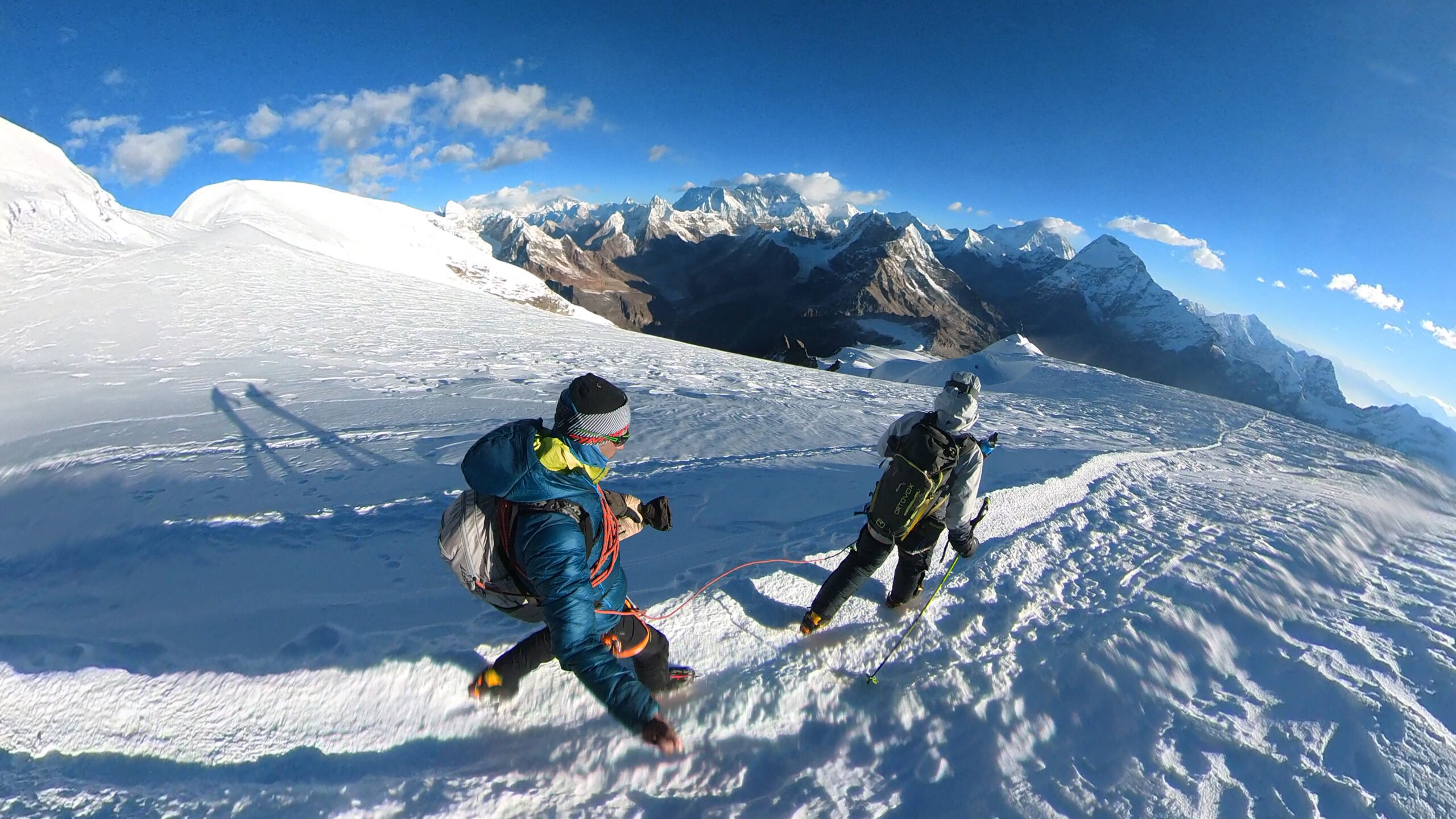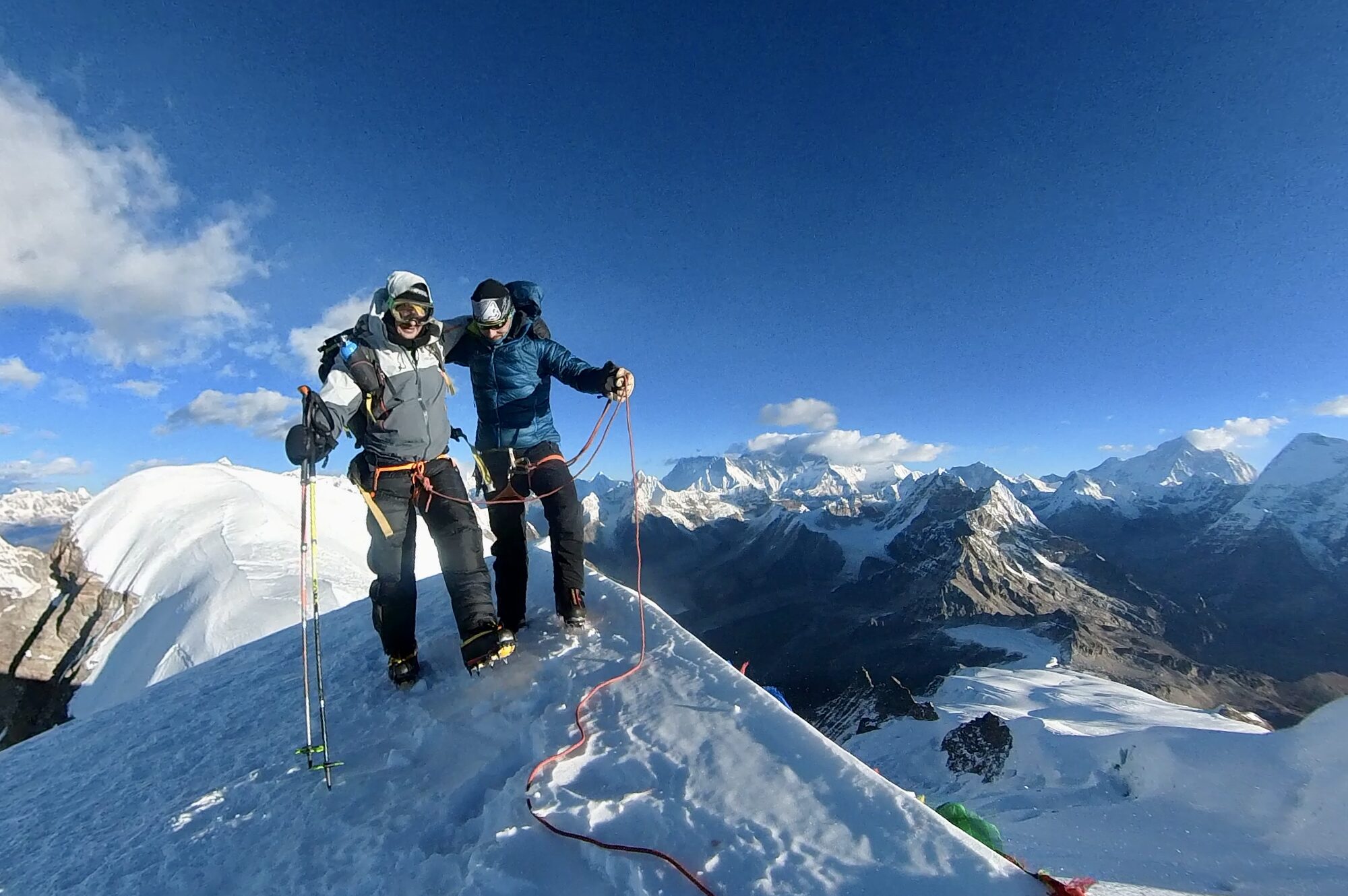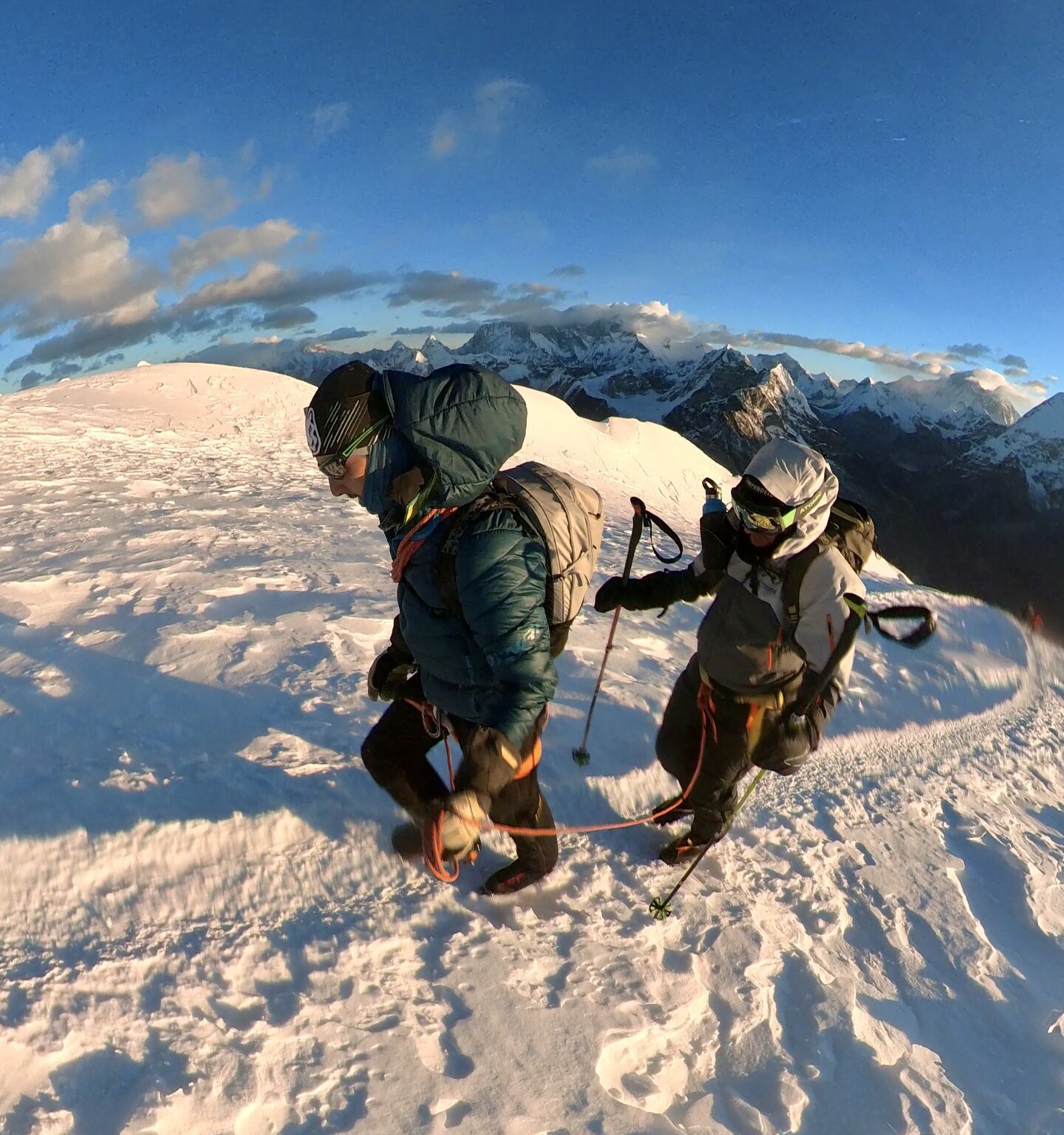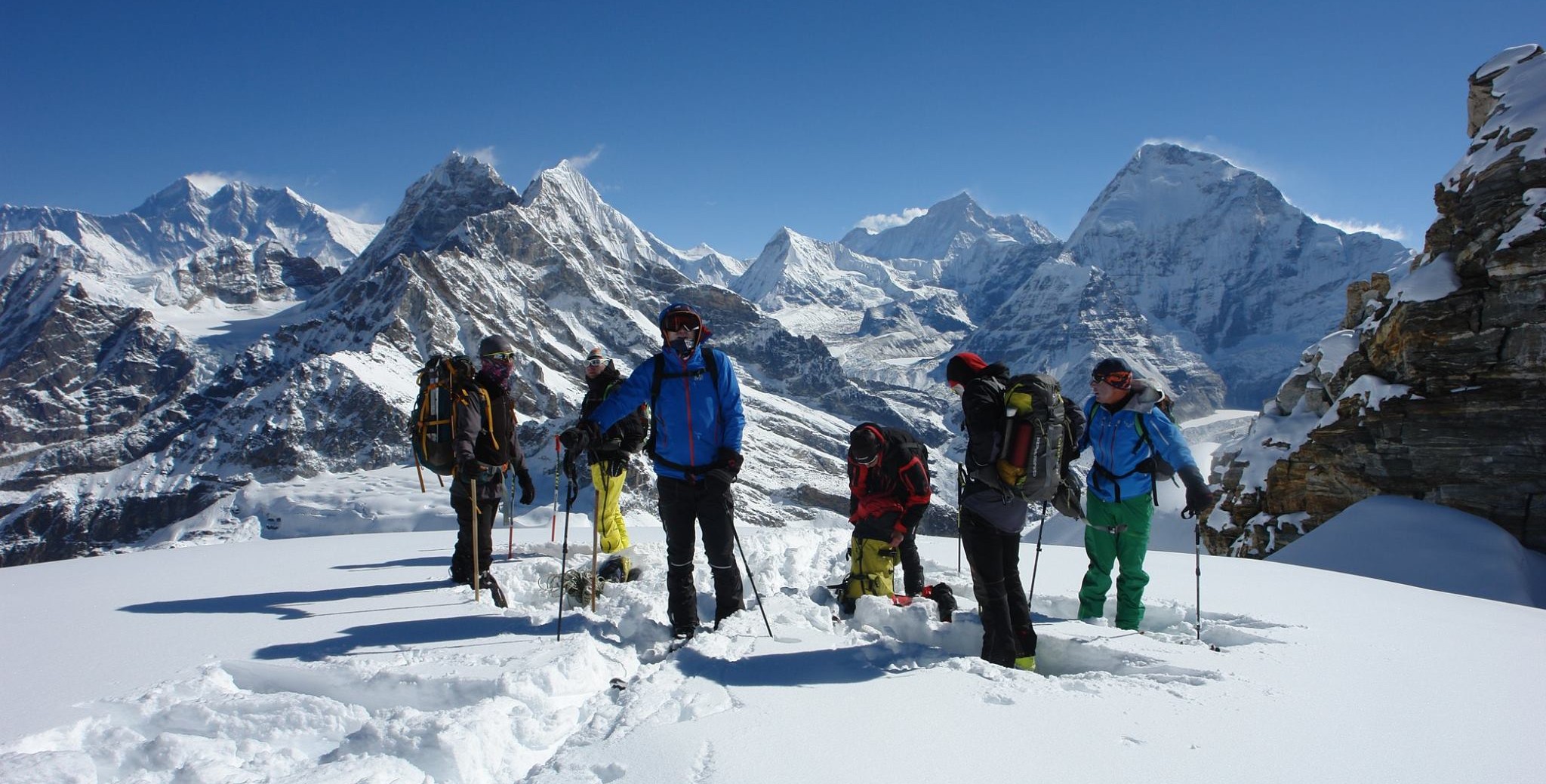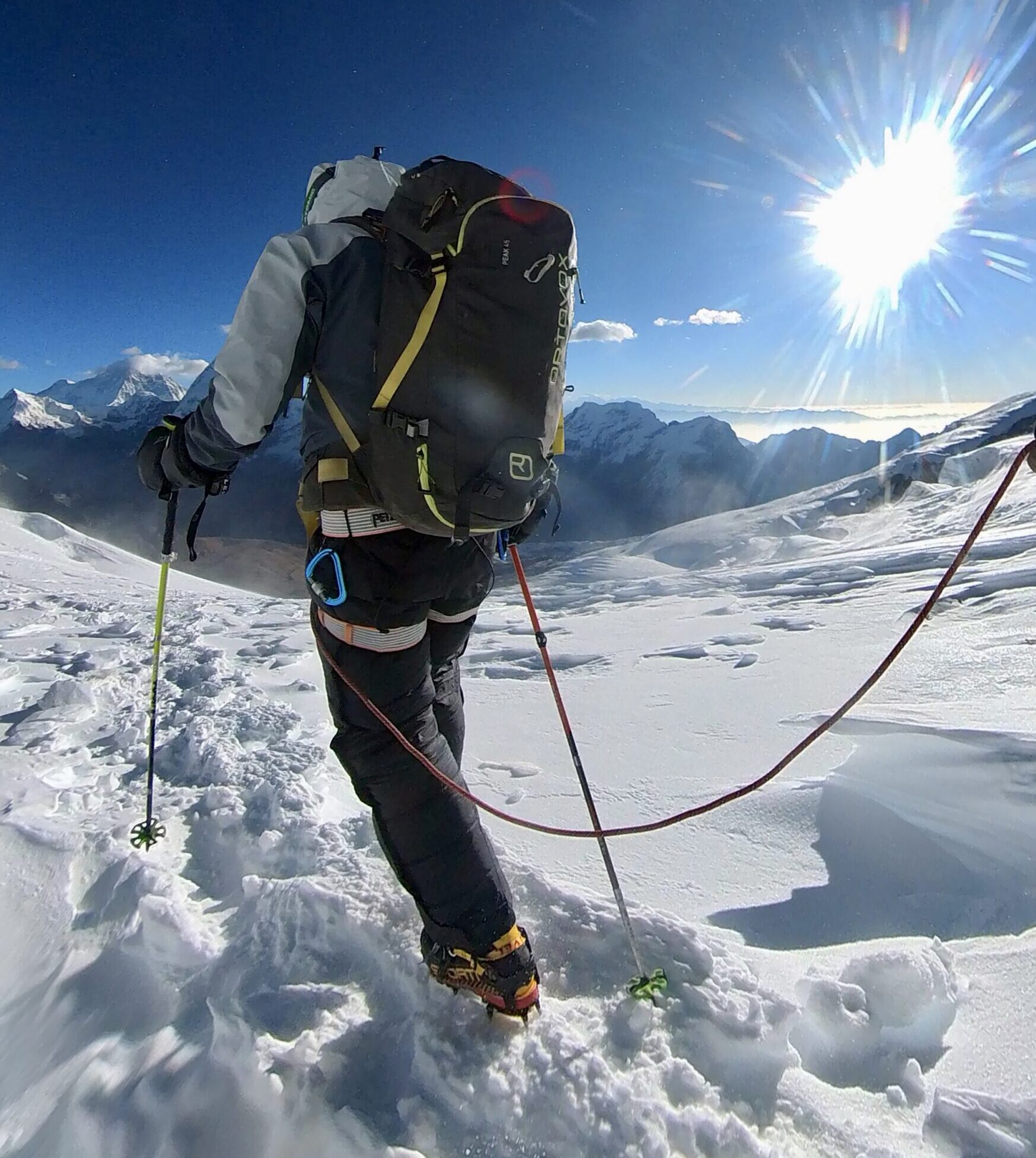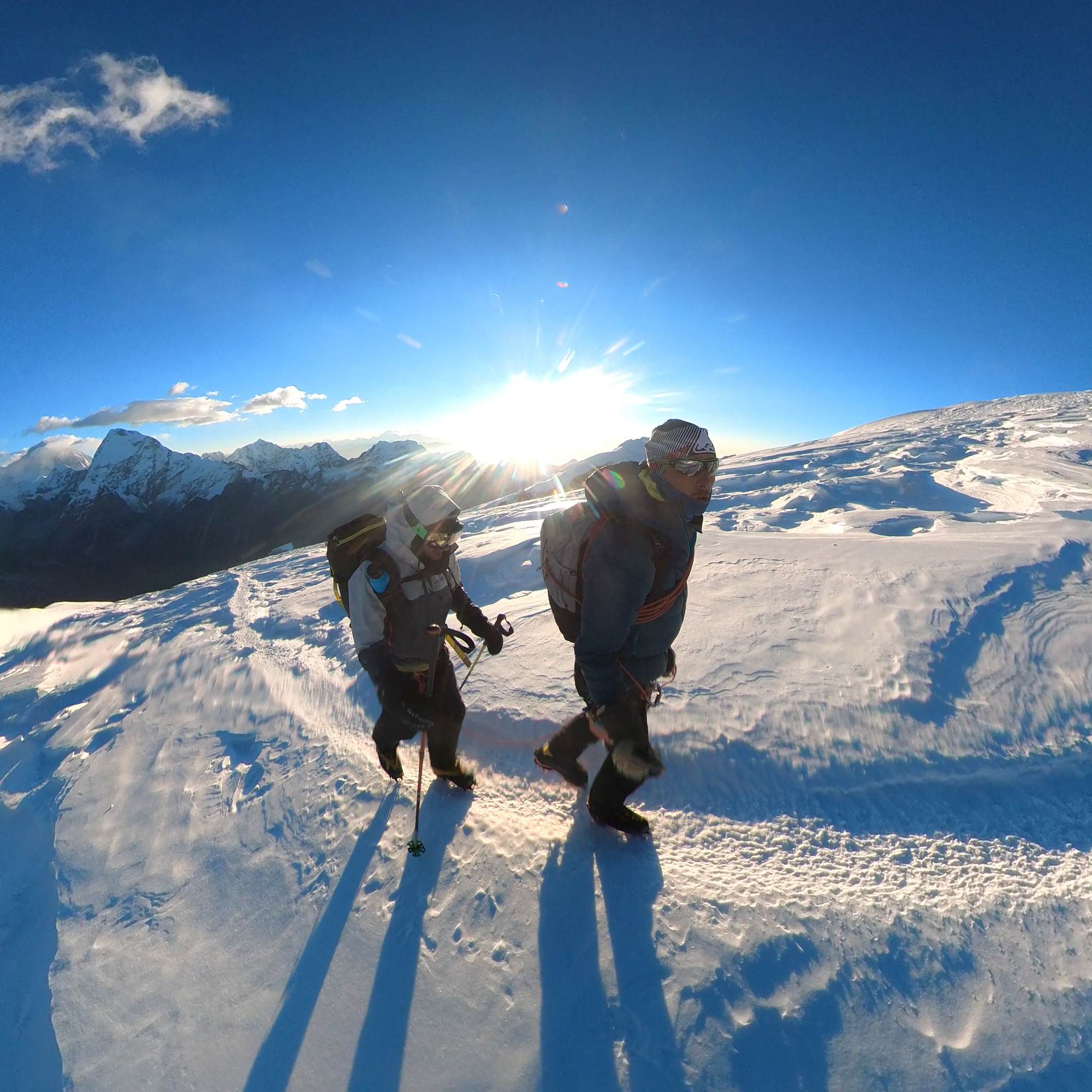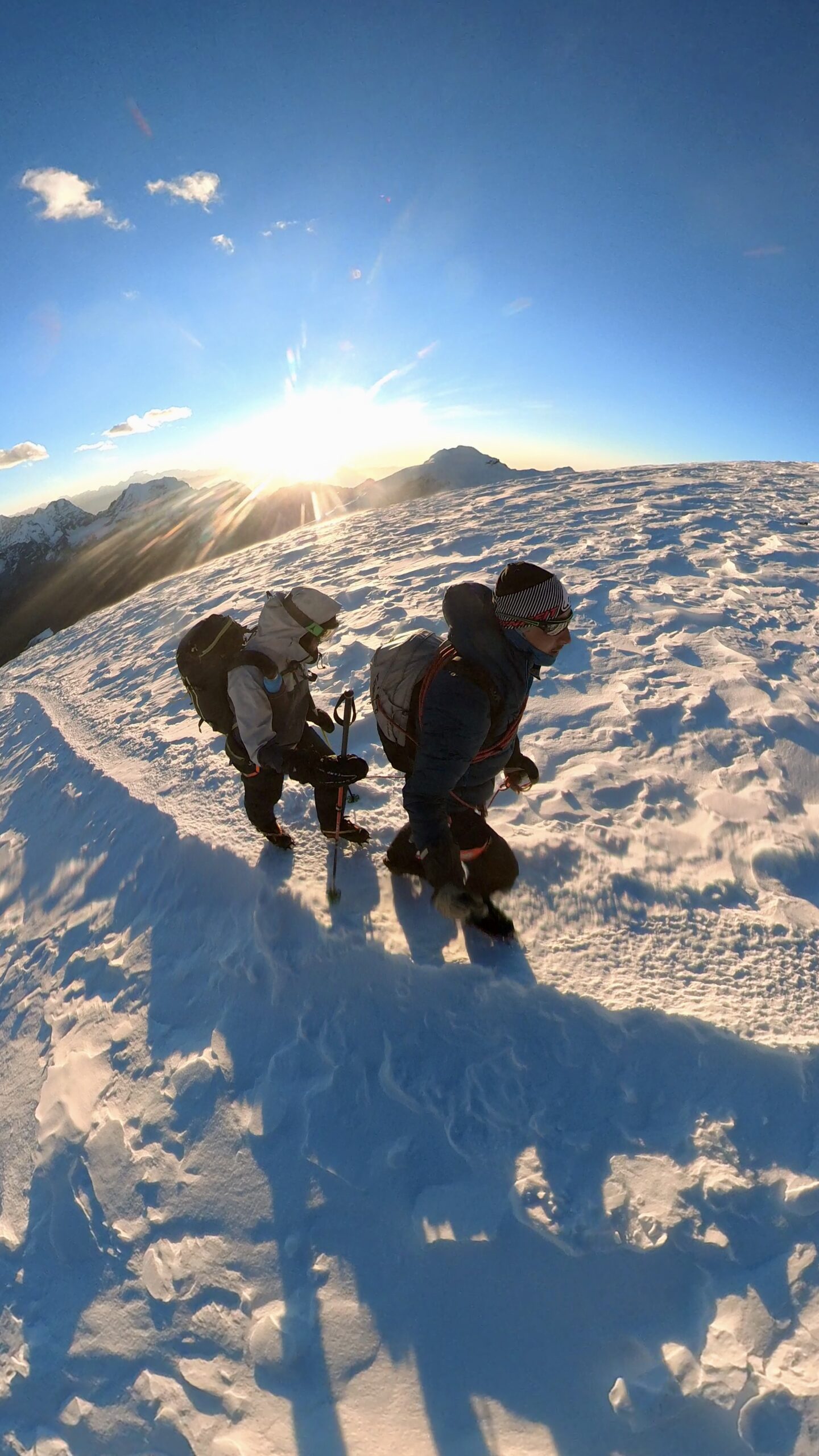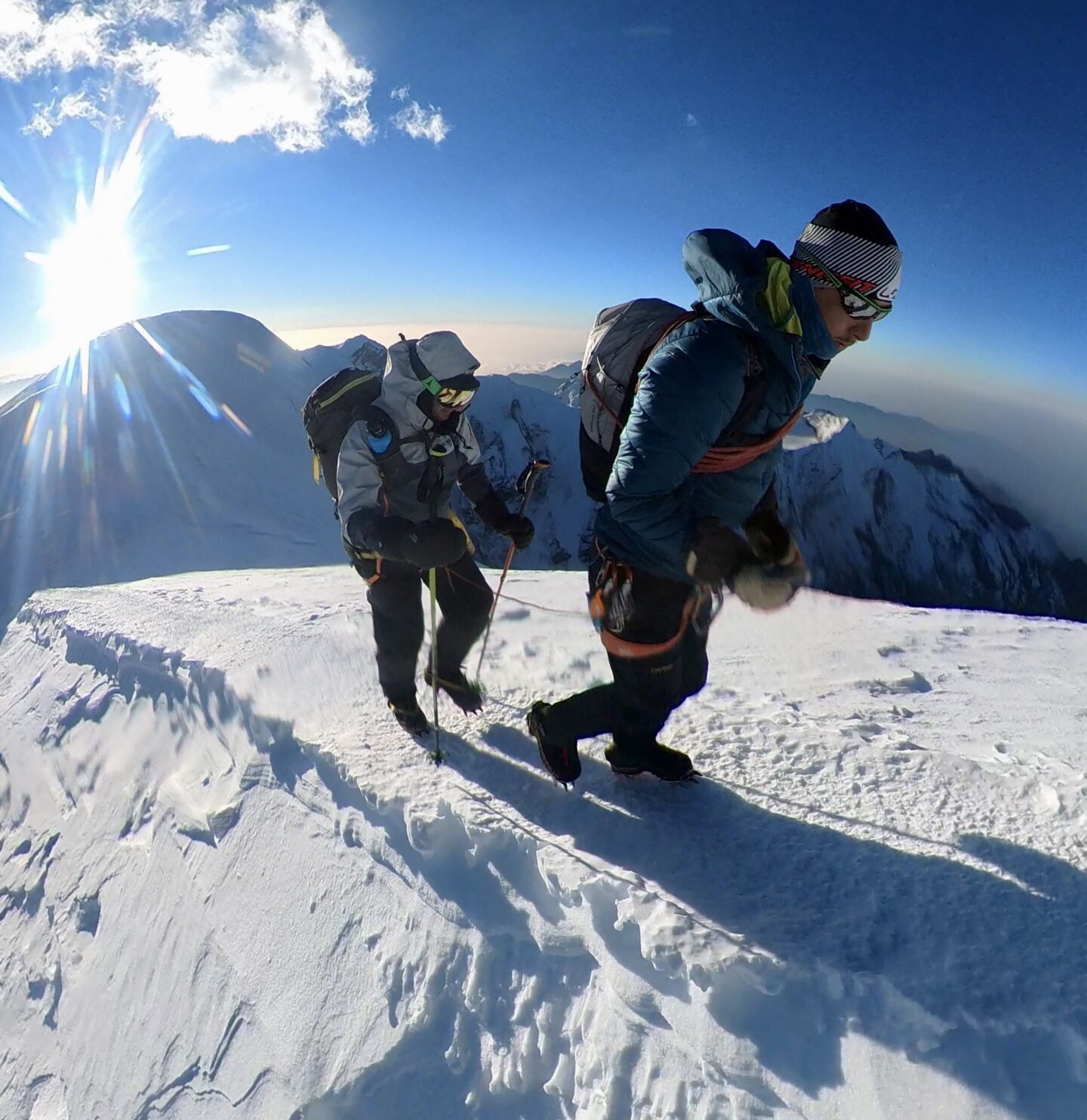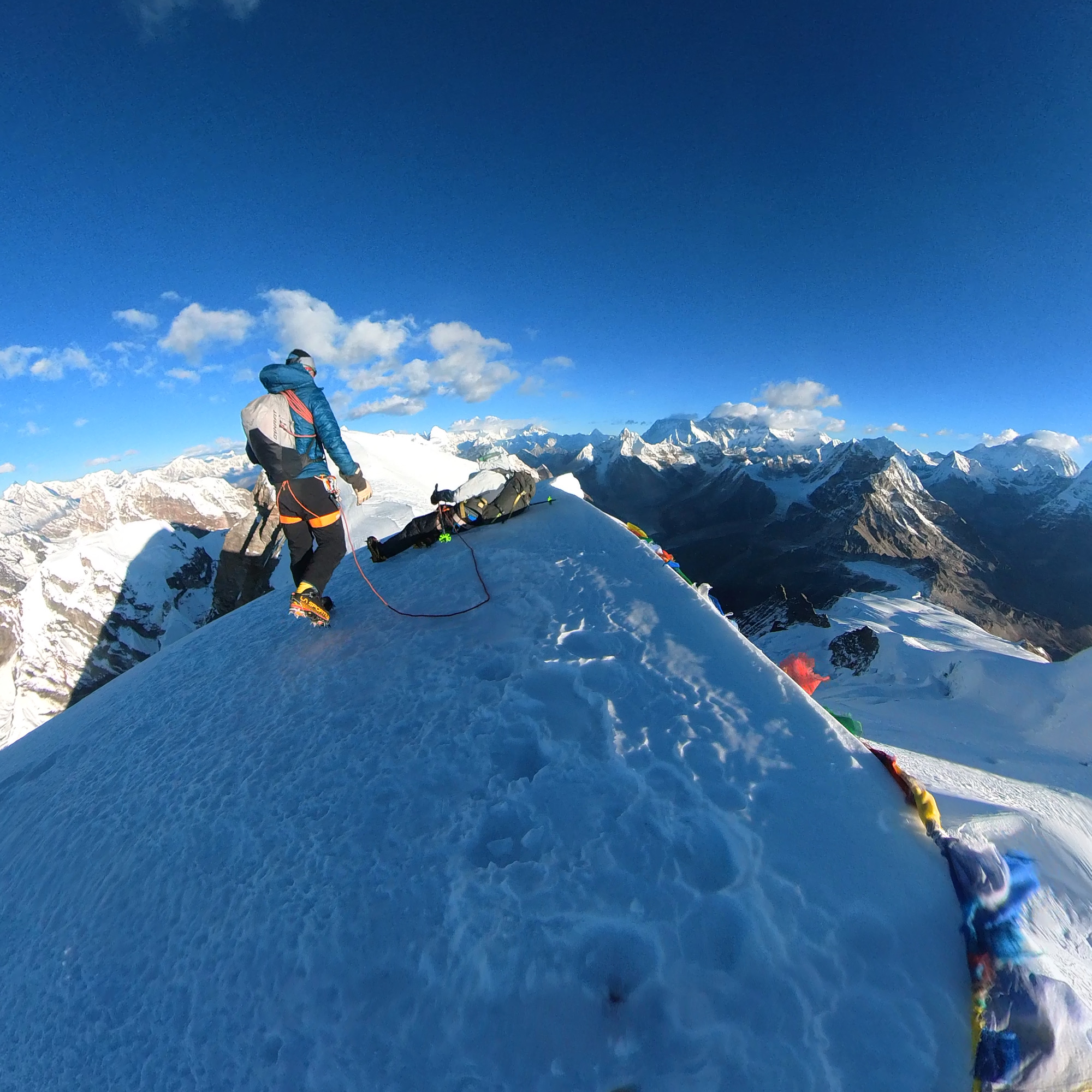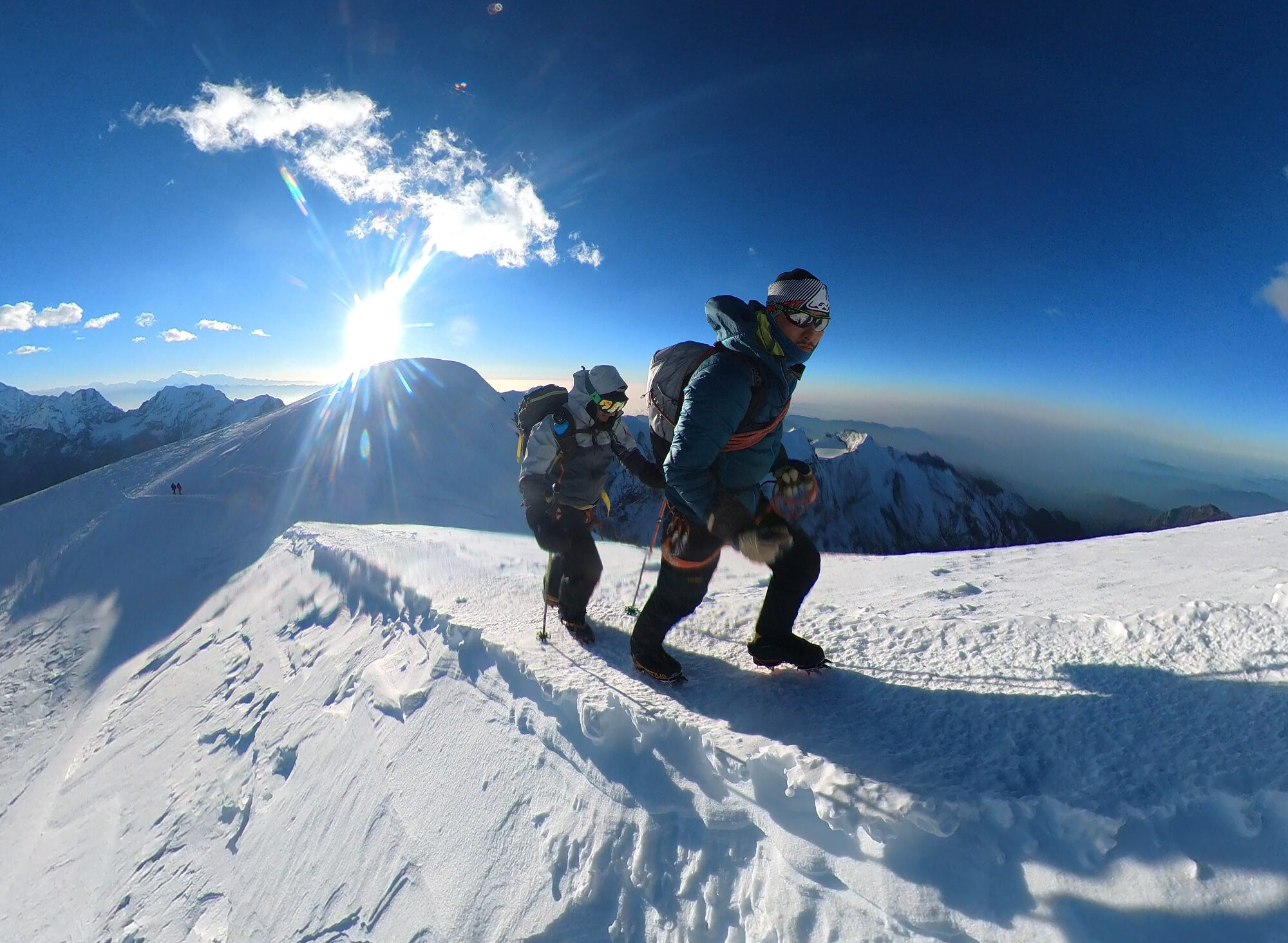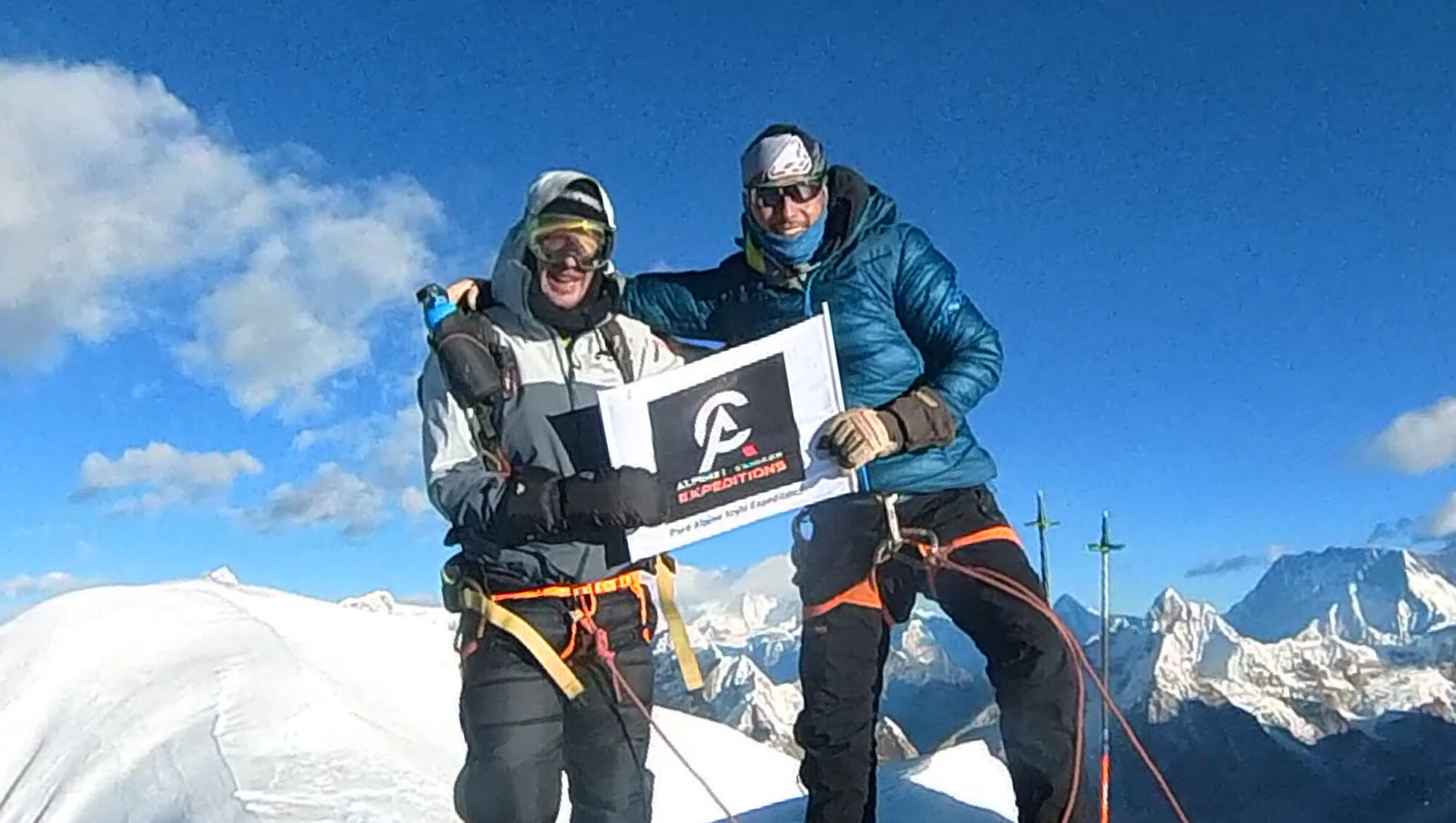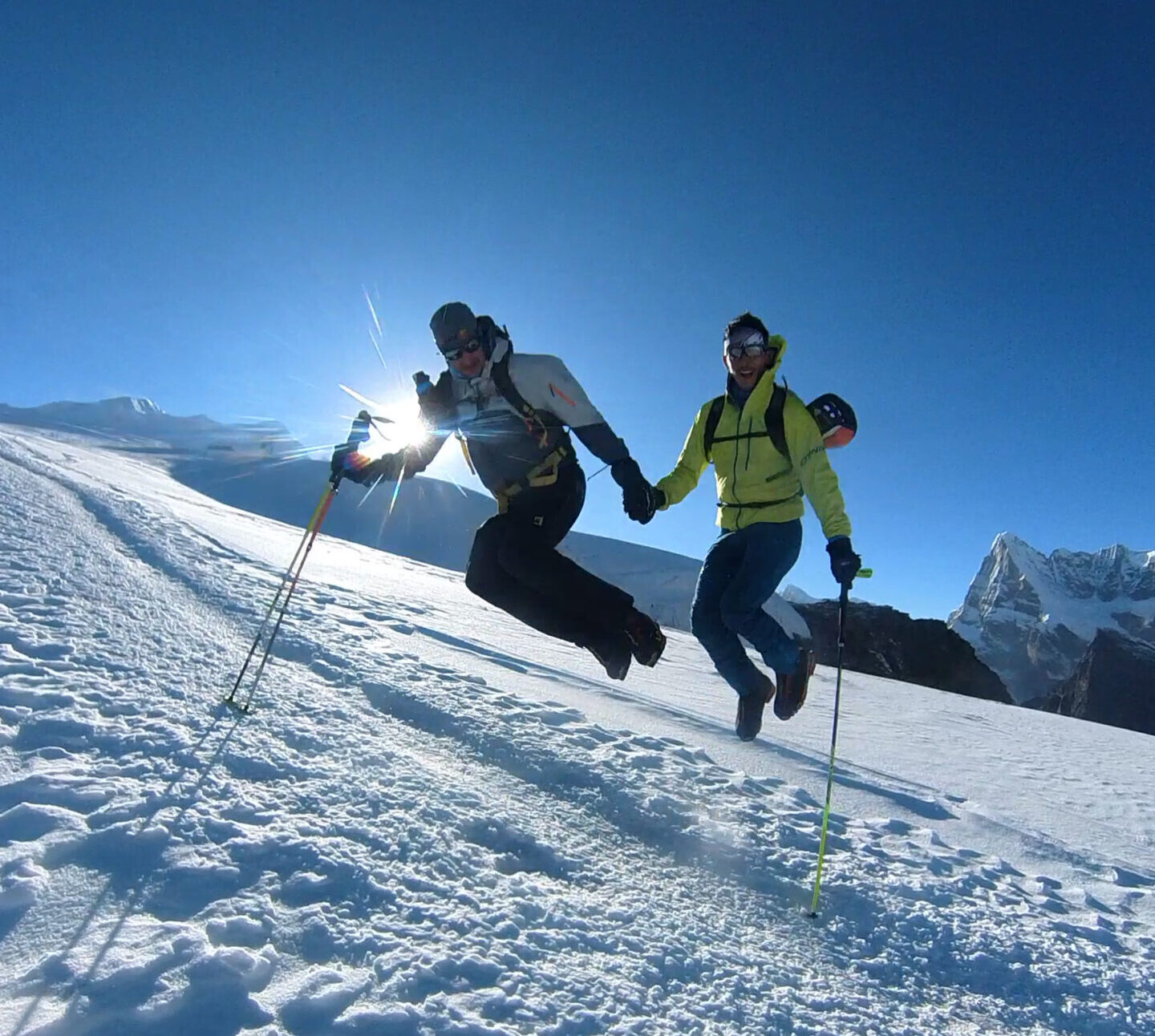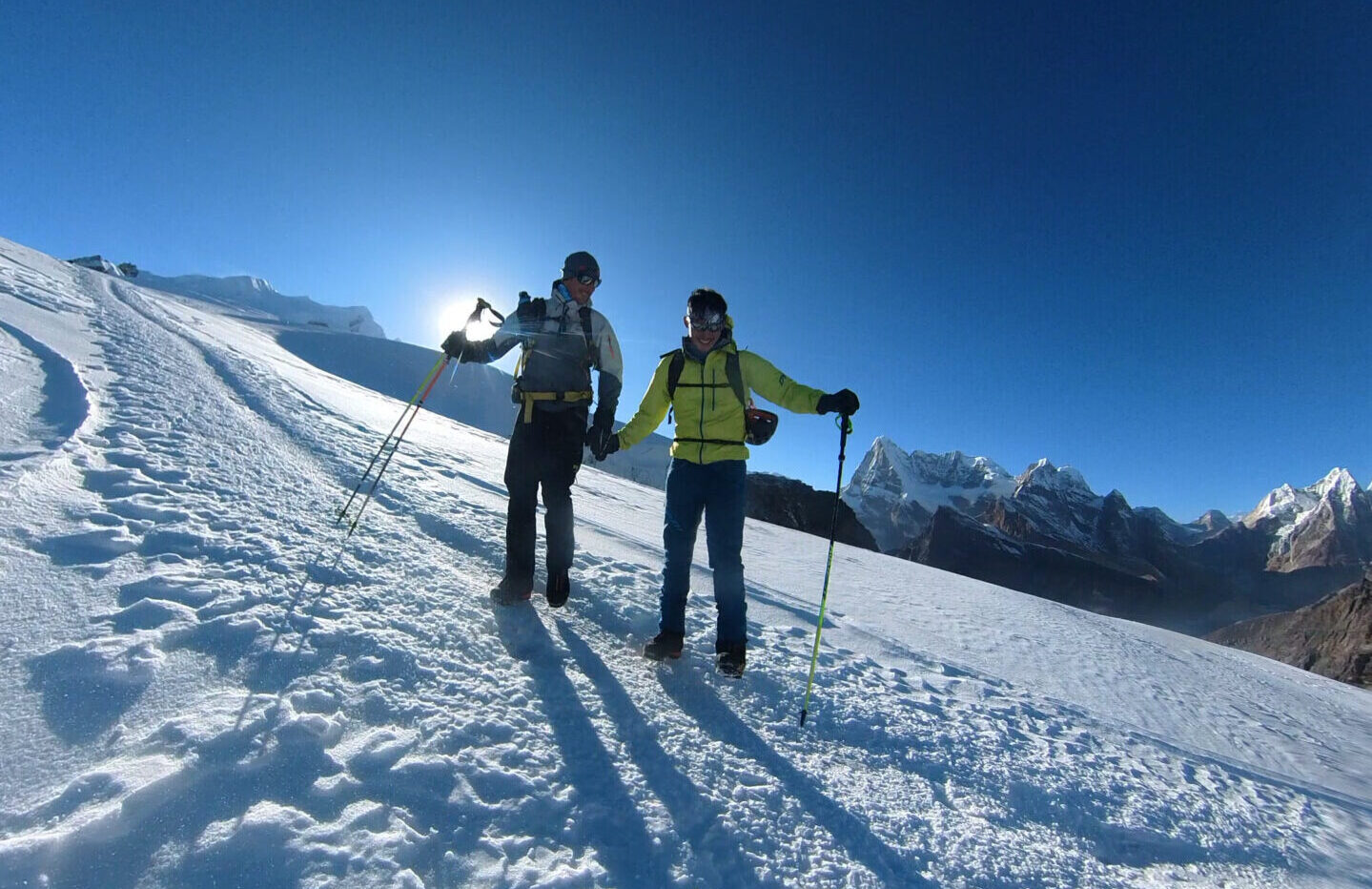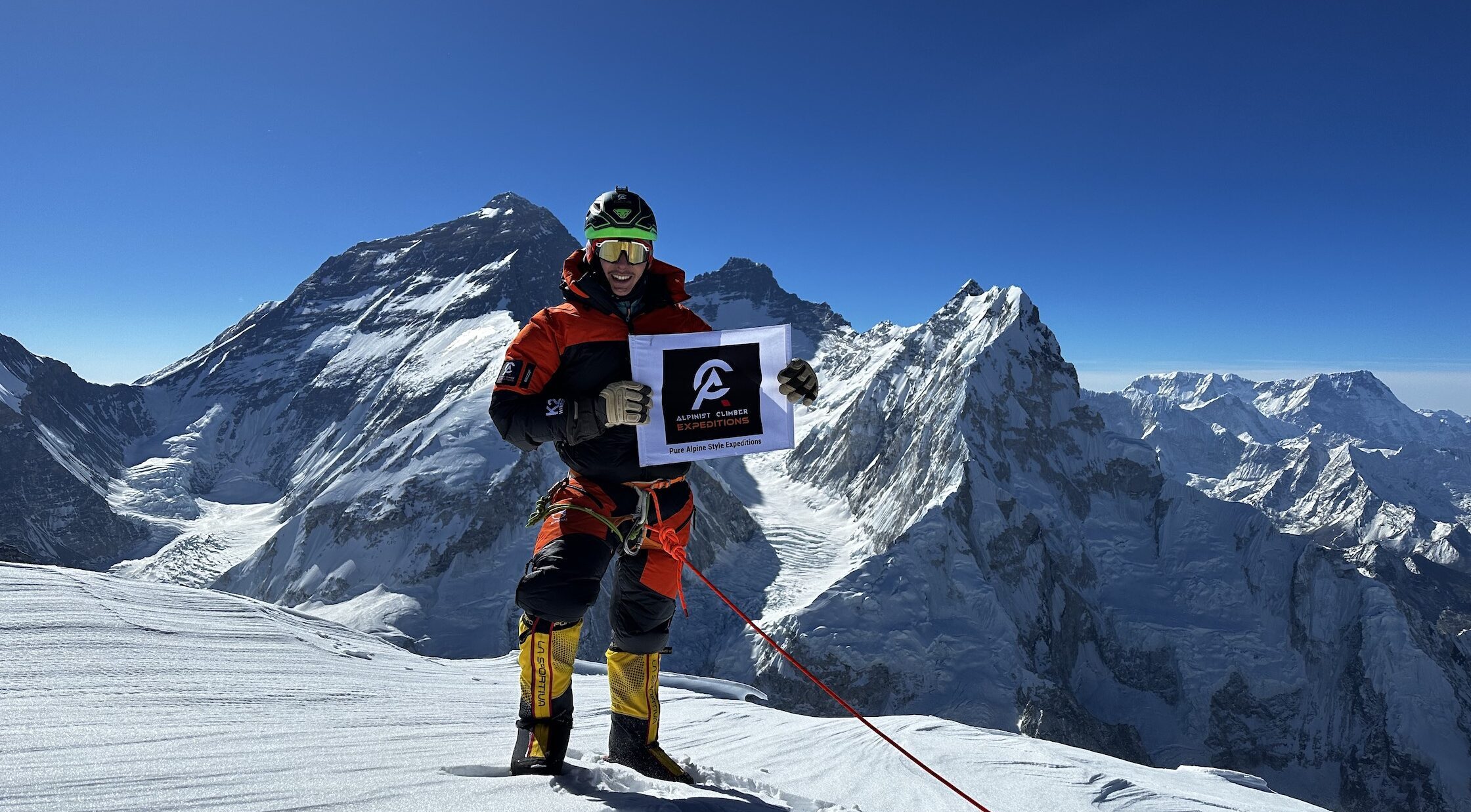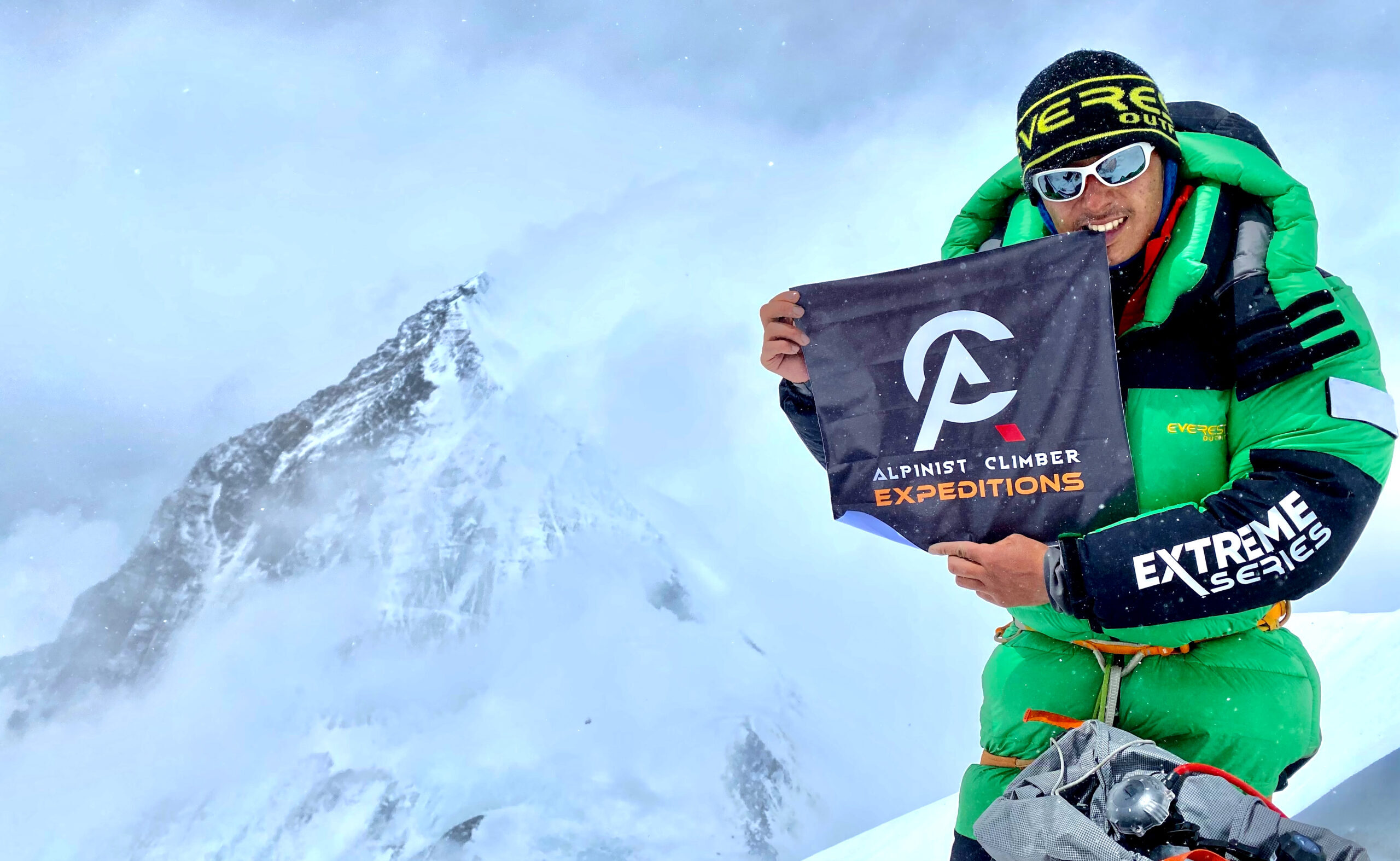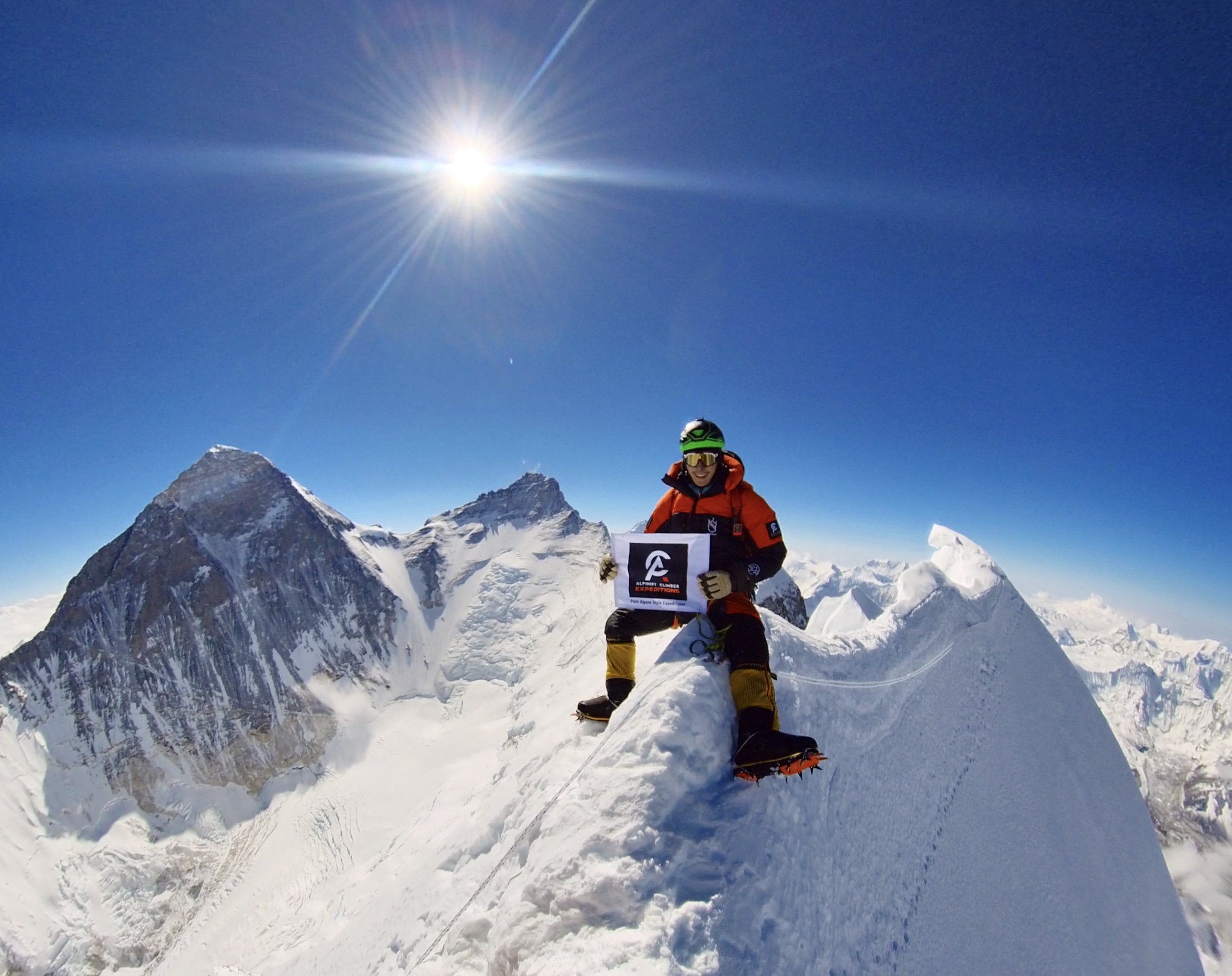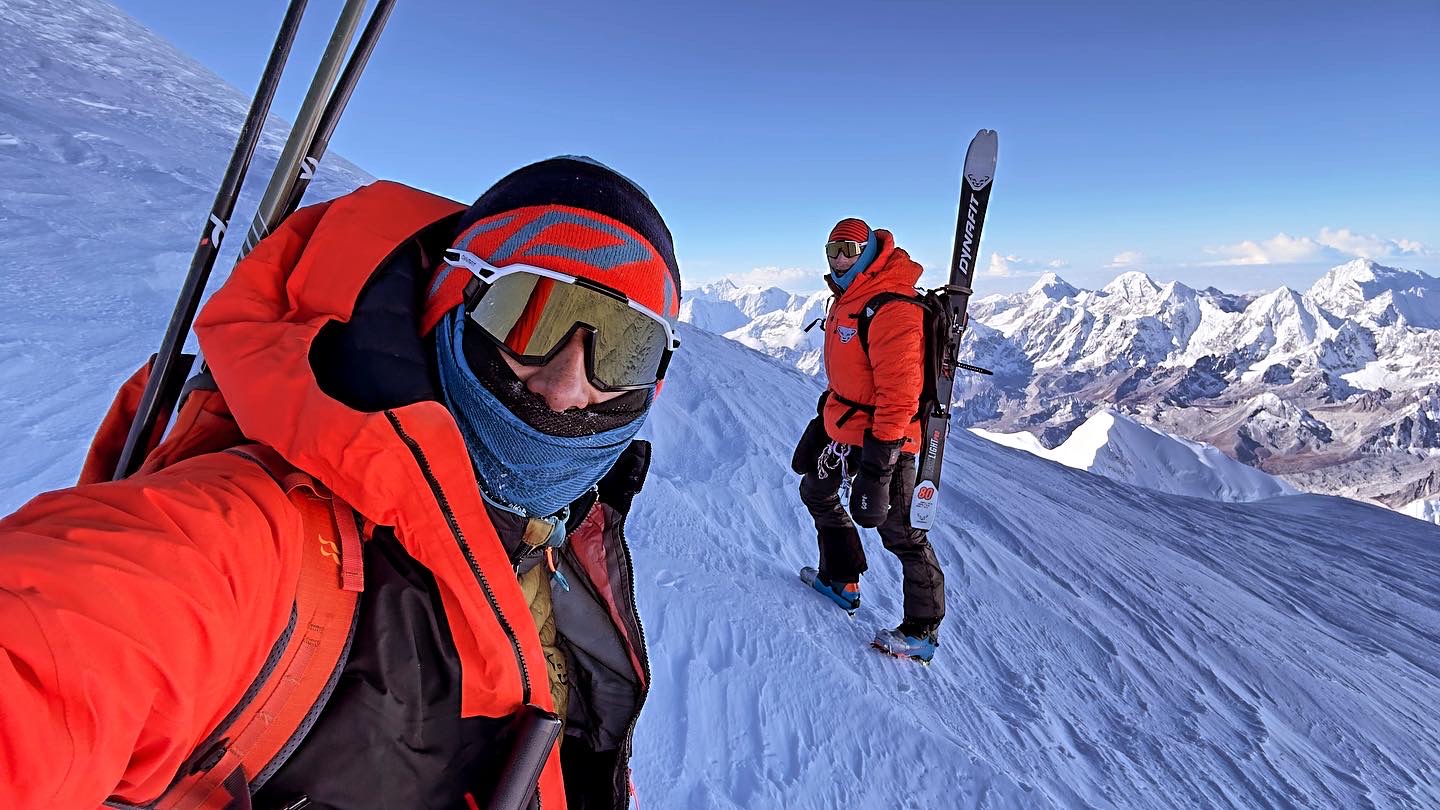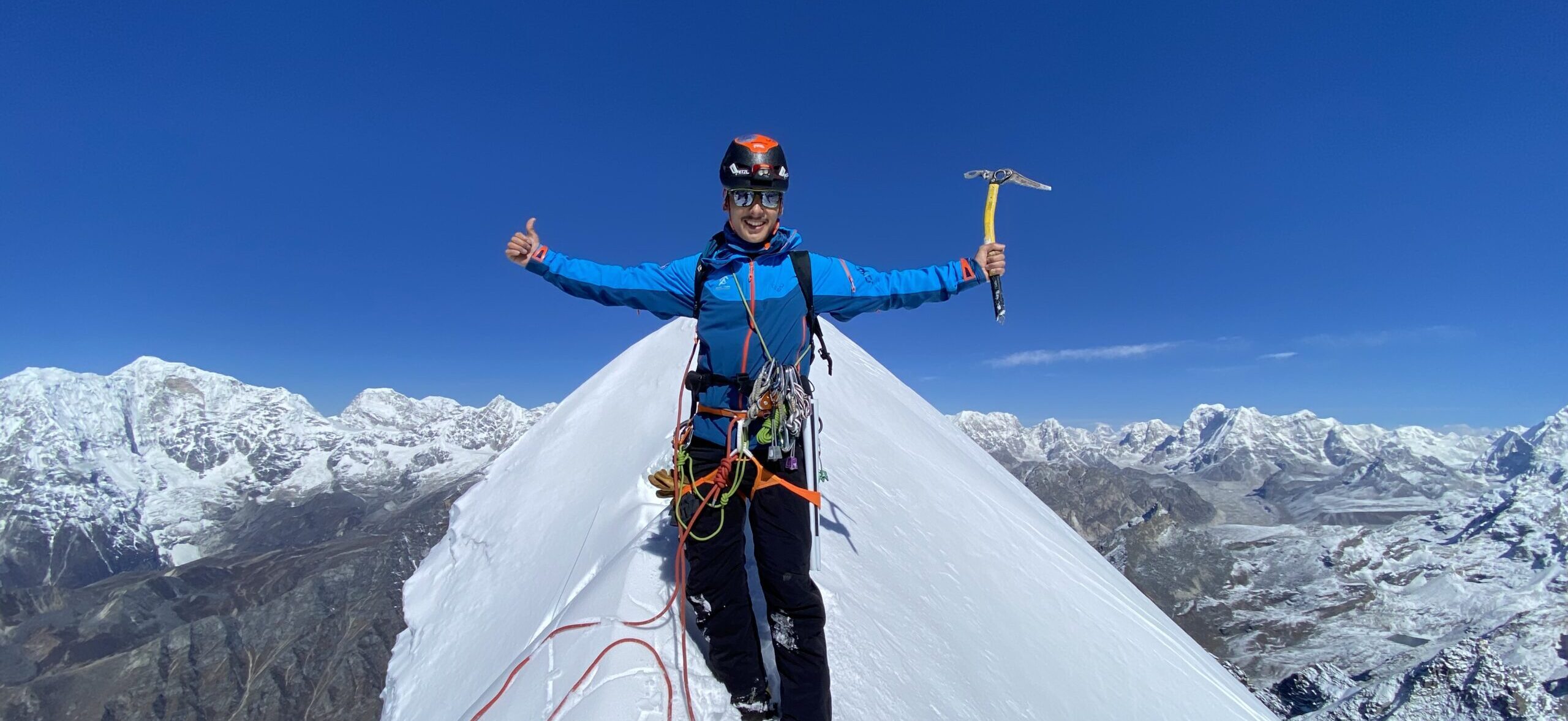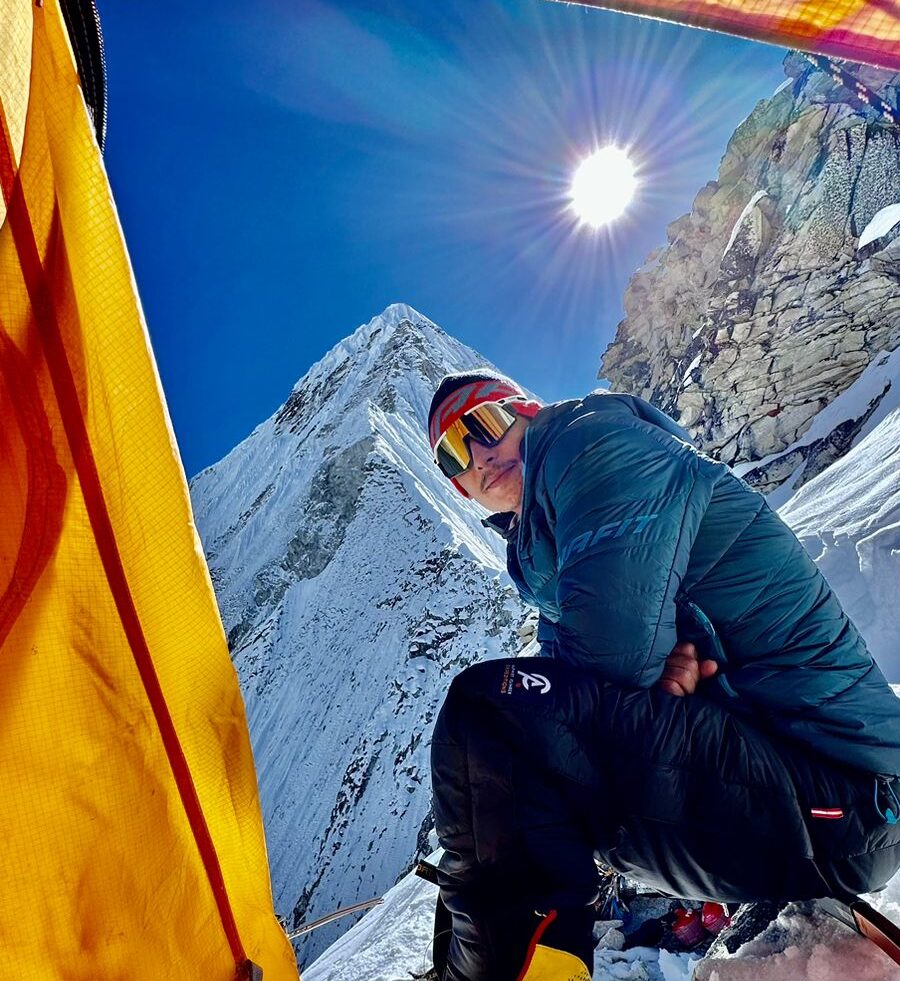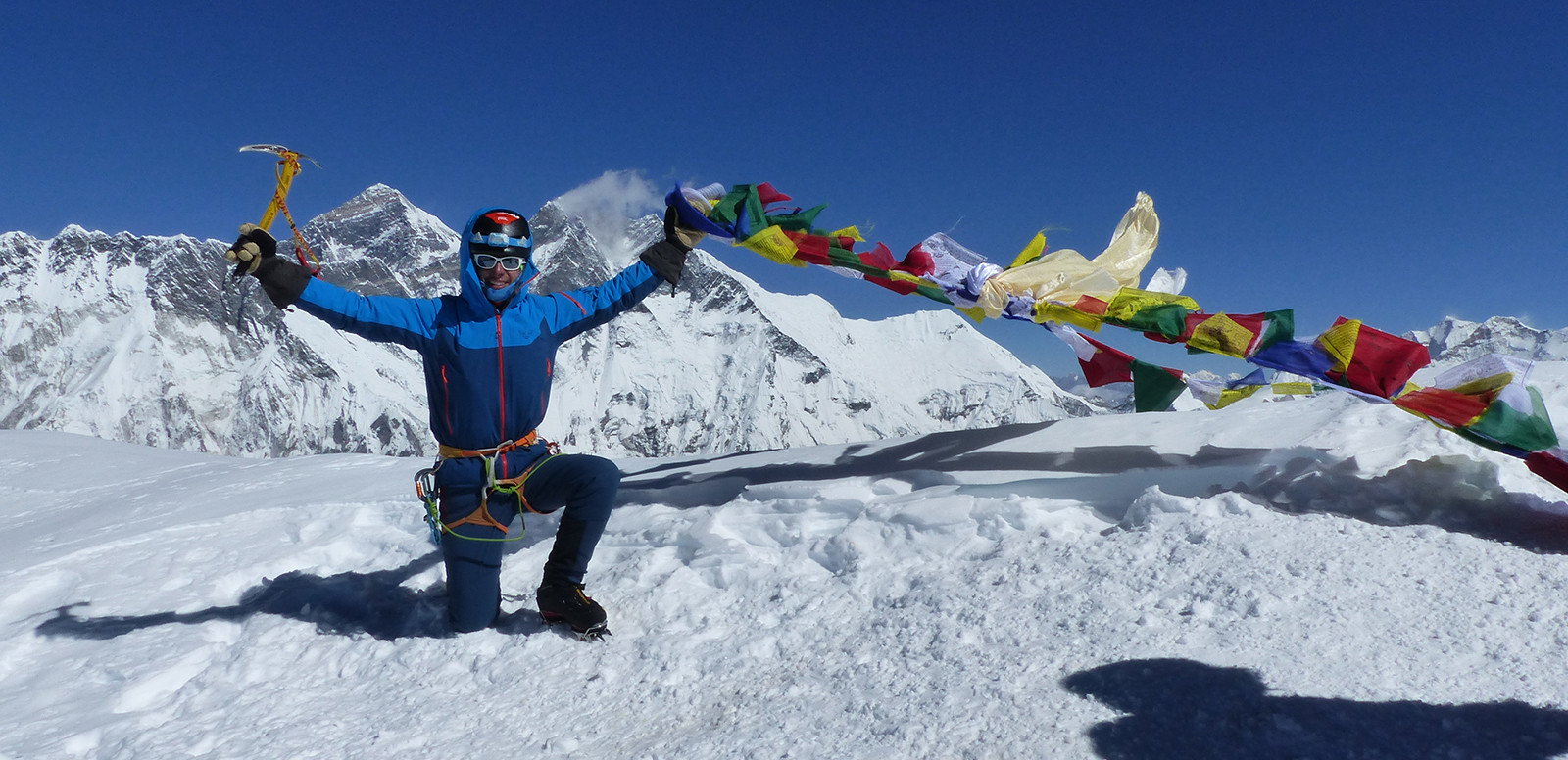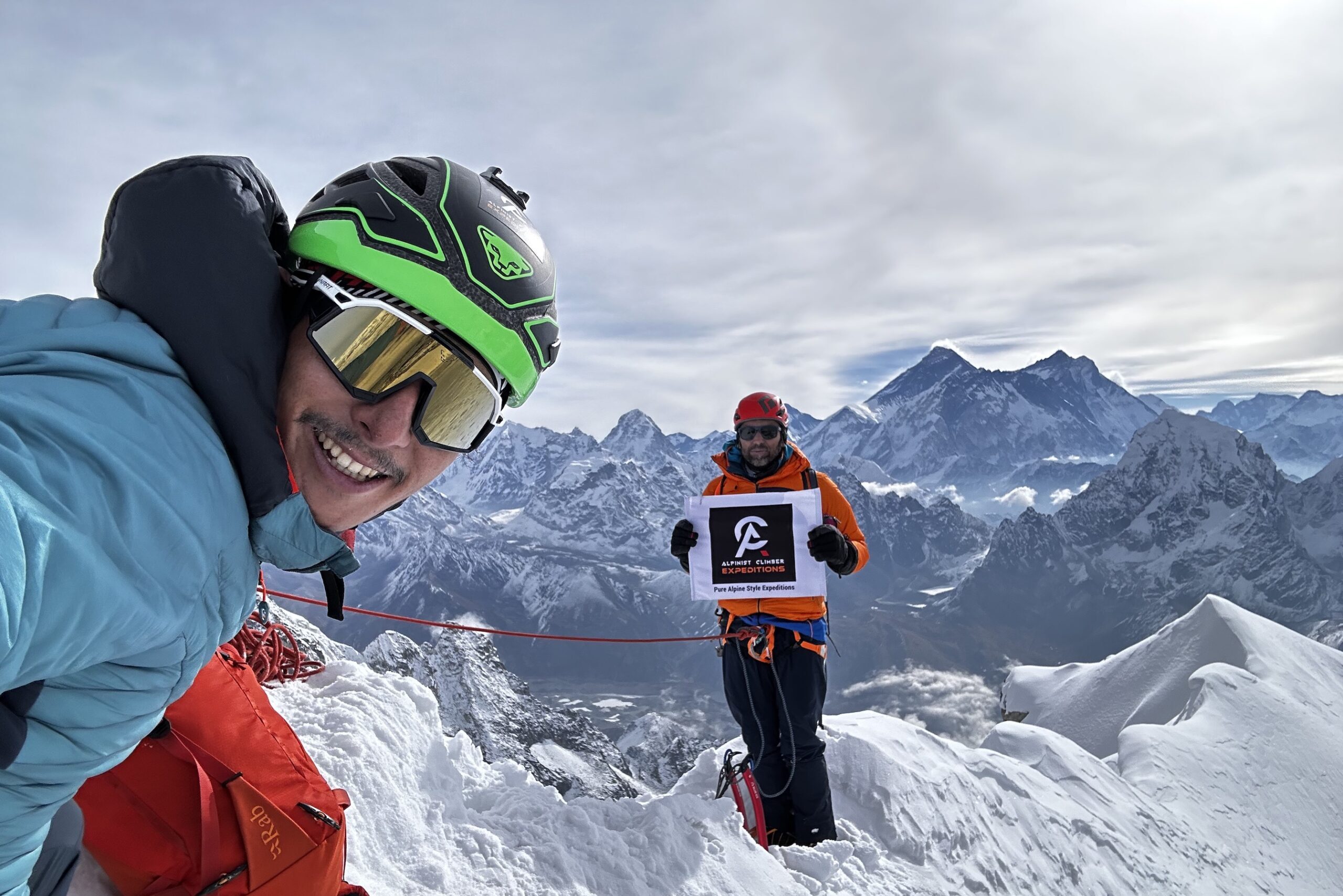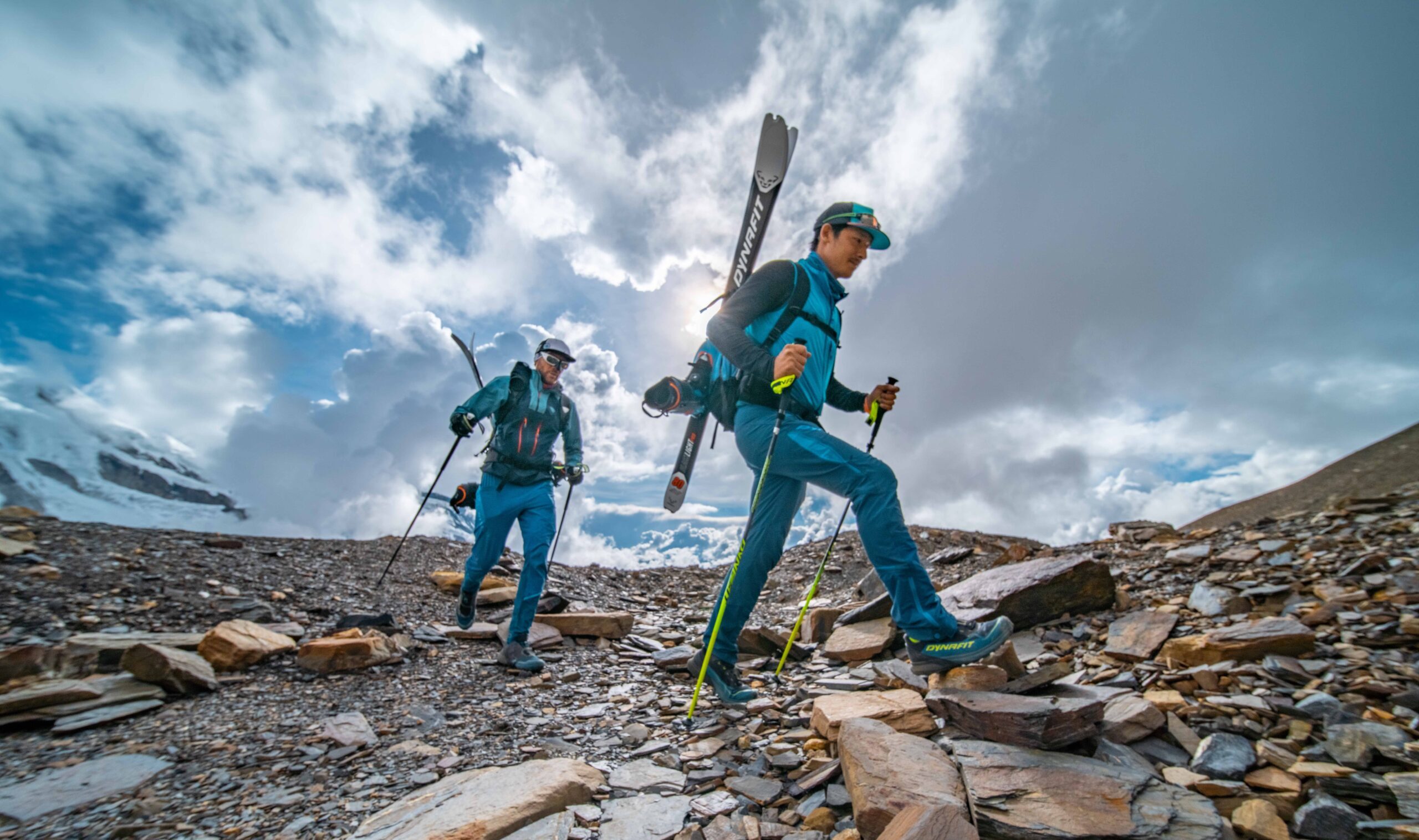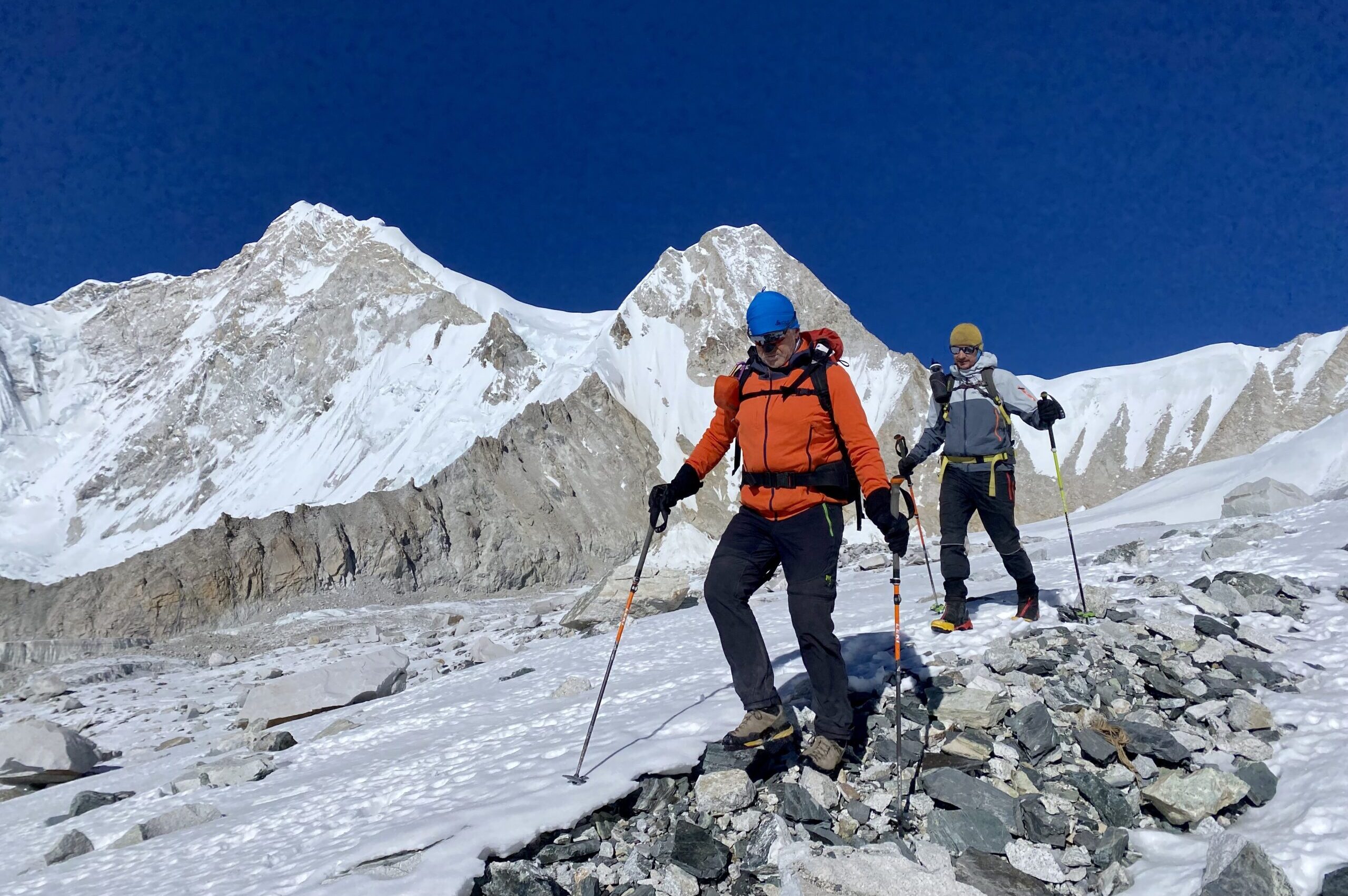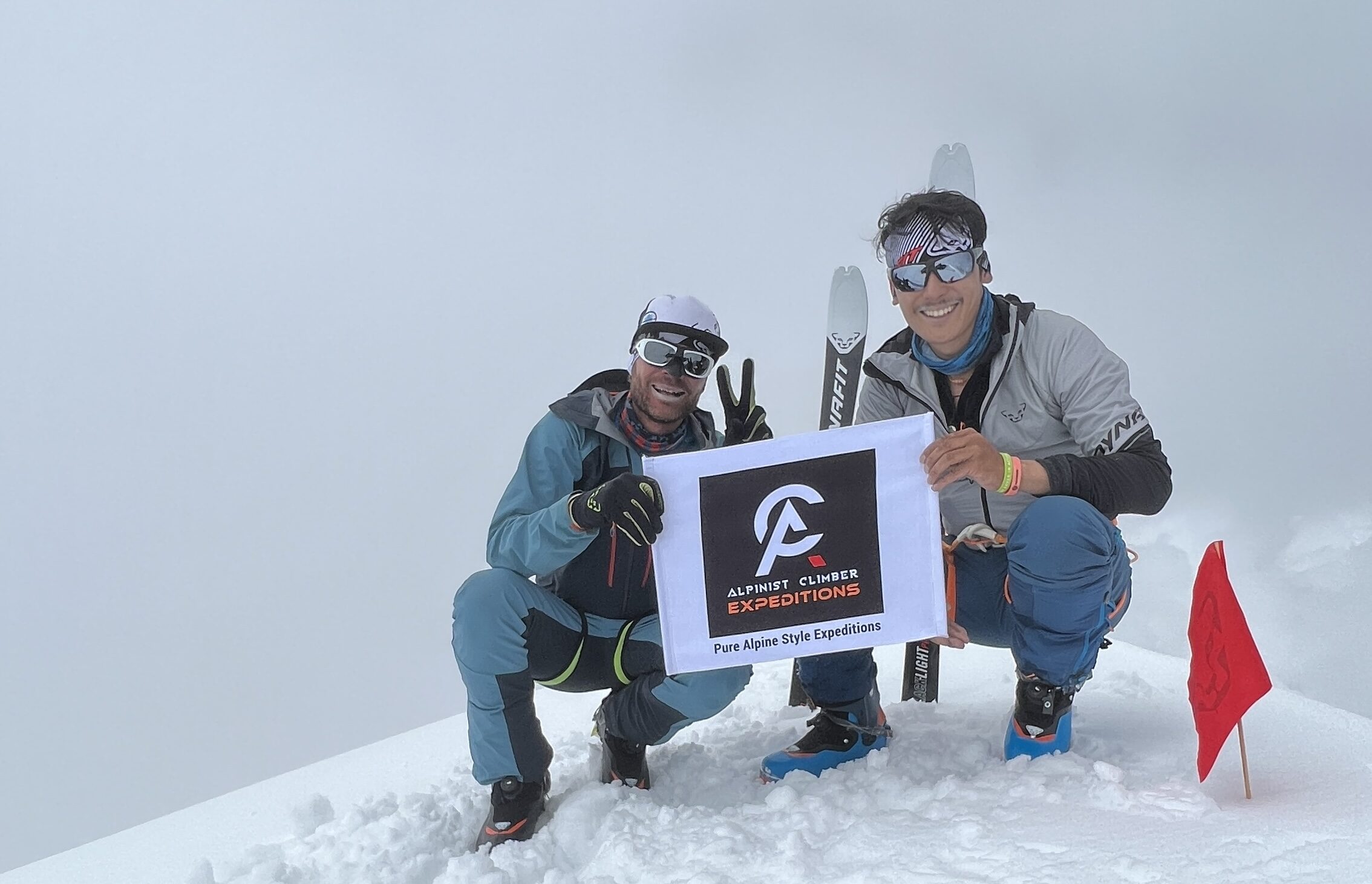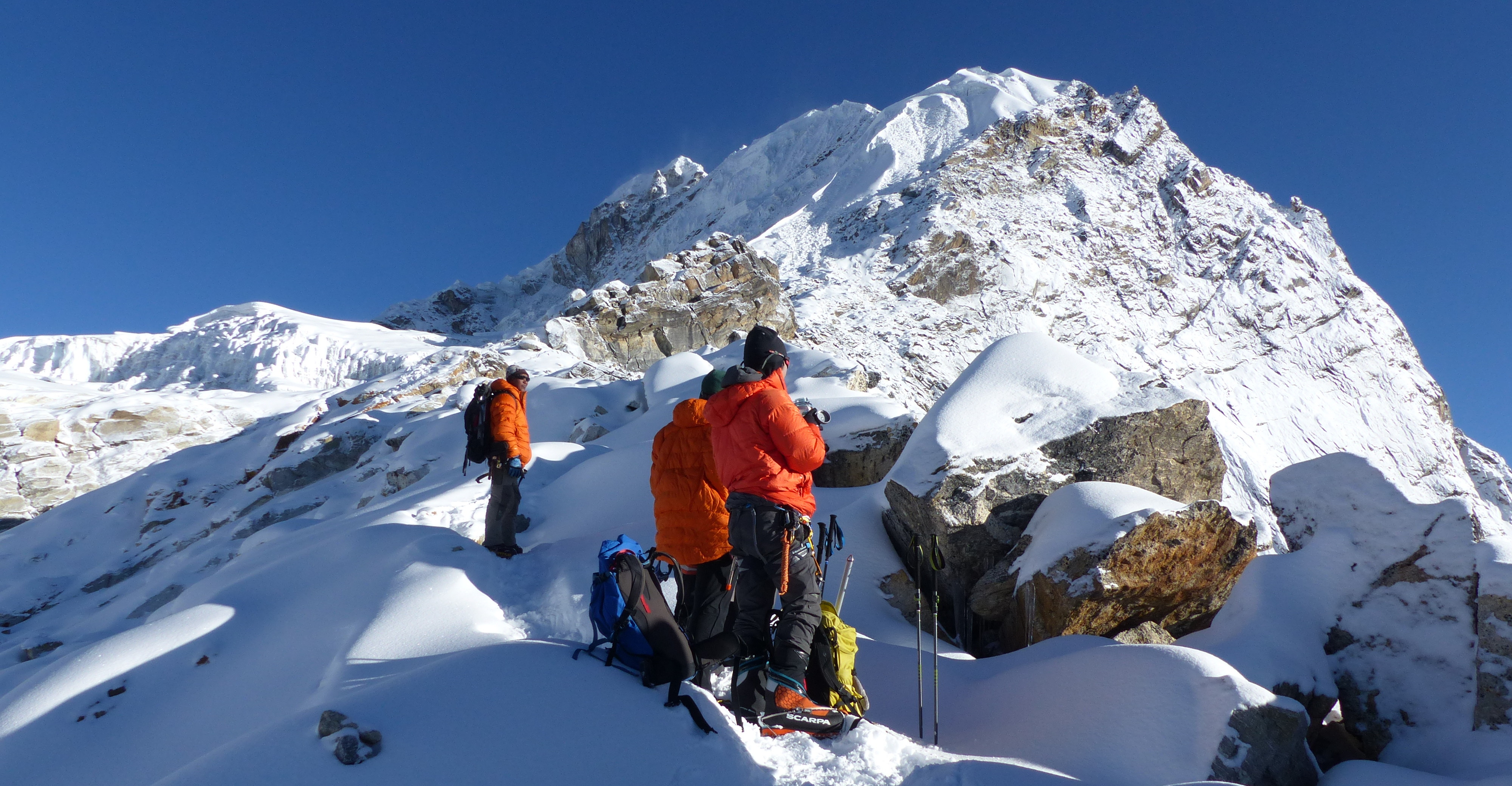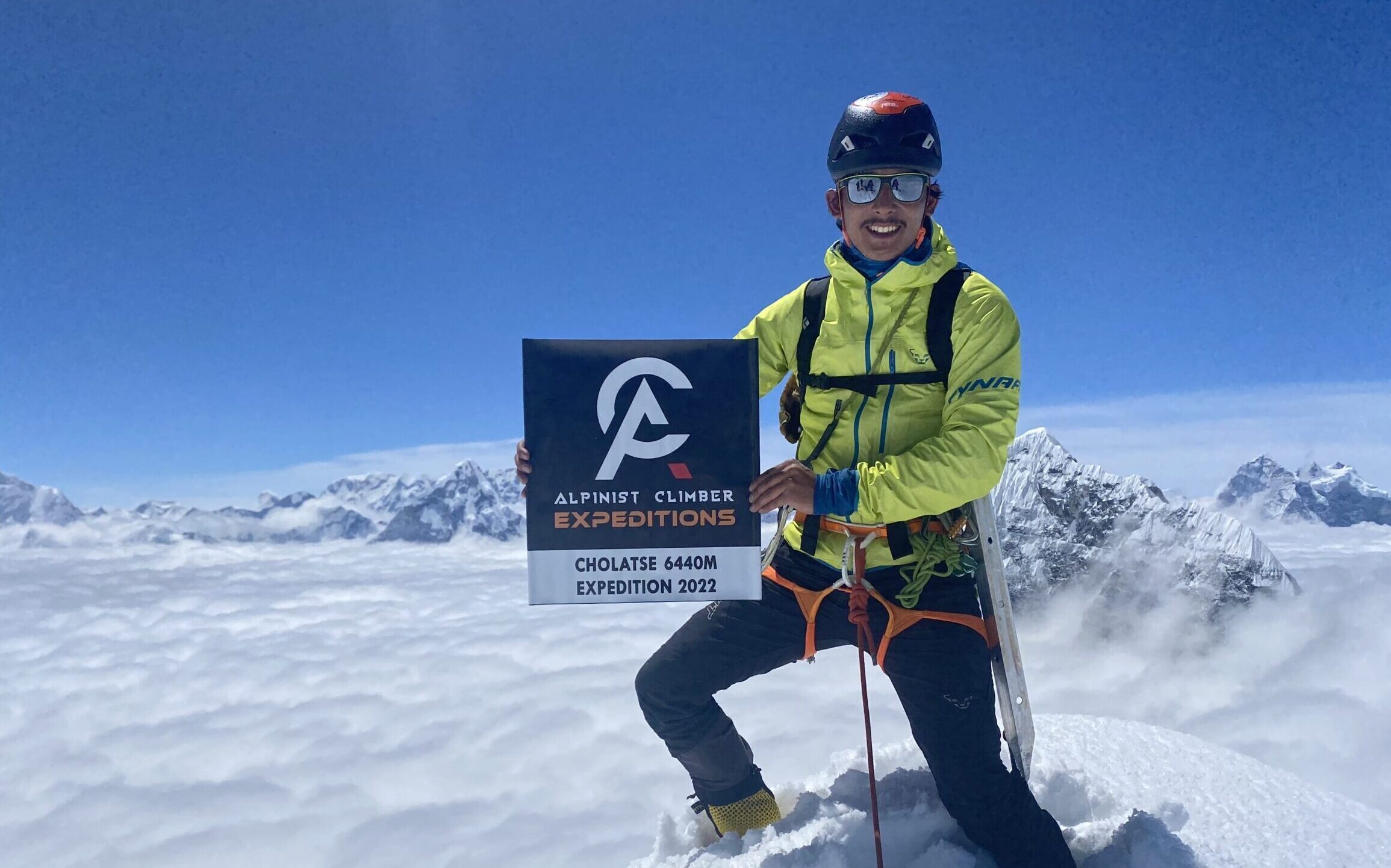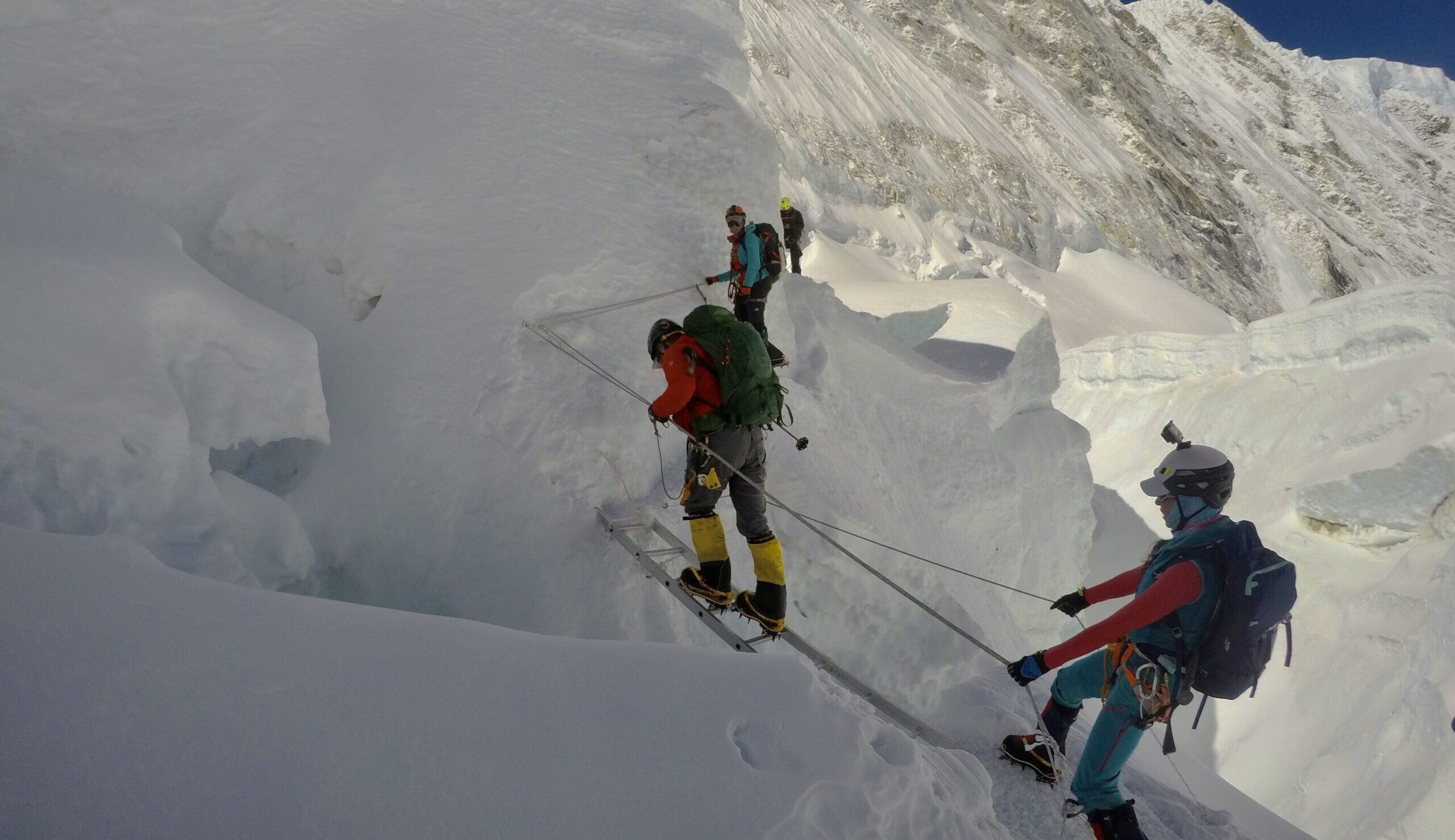Mera Peak Expedition
Rising to 6,476m, Mera Peak is a thrill in the heart of the Hinku valley region. Firstly, it offers to the climbers a chance to attempt a great 6000m peak. This trip combines hiking and scenery with cultural exploration. With our experienced guides, climbers will go through acclimatisation and training to be ready for the climb. Mera Peak does not need experience, as it is an easy peak to the ones with good hiking skills and a good fitness. Although, it is not as technical as the other peaks in the region, like Island Peak and Lobuche Peak.
The Mera peak climb starts with the trails through the villages, wild forests, and the rich local culture. You can see the view of Everest, Lhotse, Makalu, and other peaks. Lastly, this climb gives an experience of physical challenge, natural view, as well as cultural experience.
Difficulty Level
Moderate
Best Season
Autumn / Spring
Duration
19 Days
Elevation
6,476m
Group Size
3 - 10
Trip Type
6000M Expedition
2024
6000M Expedition
- Starts from Kathmandu, Nepal
Overview
The ascent of Mera begins after a week of hiking and acclimatization to ensure the best possible chance of an enjoyable and successful trip.
Mera, at 6,476m, is also one of Nepal’s highest “trekking” peaks. Mera peak Climbing leads you through the remote Hinku Valley to the top of Nepal’s highest trekking peak. The climb up Mera Peak, located in Solu Khumbu, the area containing the world’s five highest peaks, is demanding but non-technical. The route to the peak is straightforward, with inclines of no more than 30 degrees. If you are an amateur climber searching for a high-altitude thrilling adventures as your first Himalayan peak, Mera Peak is the mountain for you. Climbing Mera Peak is a one-of-a-kind experience because you will be rewarded with amazing views of jagged mountains surrounding the summits, which are some of the tallest mountains in the world.
One can get mesmerized by more than twenty mountain peaks greetings of 5 eight-thousanders — Mt. Everest (8848 m), Mt. Lhotse (8516m), Mt. Makalu (8486m), Mt. Kanchenjunga (8586m), and Mt. Cho Oyu (8201m) whenever the sky is blue and clear.
Itinerary
Day
Arriving In Kathmandu
When you arrive at Kathmandu airport our representative from Alpinist Climber Expeditions will be there to greet you and when you have gone through customs formalities our representative will pick you up and transfer you to your hotel. Once you are checked in our climbing guide and other participants will go through the final preparation for the trip. In the evening get ready to be introduced to Nepali cuisines.
Trip briefing & Preparation
We brief you about Mera Peak climbing today. We discuss the route we take and give you information about how each day will be like. There will be gear and equipment check as well.
Drive to Patale Danda
We got up early in the morning at 6am and we will start our journey to Mera peak. We will take a private Jeep from Kathmandu to Patale, between Kathmandu and Patale we will stop for a tea and lunch break. During our drive, we will see cultural and traditional villages and mountain views Everest, Lhotse, Makalu, Mera Peak, DudhKunda, and many others. Sleep overnight at local lodge Patale.
Drive to Bung
We will wake early in the morning, take breakfast and start our journey. The drive from Patale Danda to Bung actually is not long but takes time due to its rugged road. During our drive, we can take a break in local villages for lunch and tea, on the way to Bung we can see traditional and cultural villages. Bung is a village development committee in solukhumbu district in the sagarmatha Zone of north-eastern Nepal. We will stay overnight at a local house.
Trek to Surke La
Our trek begins from Bung to Surke La early in the morning at 7:30 am. Before Surke La, there is a Sherpa village called #Khiraule, where we will stop for lunch and tea. If we are lucky, we might see some wild animals on the way like the Red Panda, Deer, Bear, and many other mammals. During dinner time we will make a briefing for the next day’s activities. Sleep at Local houses.
Trek to CholimKharka
We will immediately start our hike to Cholimkharka. Until Cholimkharka there will be a forest hike, where we can see interesting flora and fauna and if we are lucky, we might see some wild animals on the way like the Red Panda, Deer, Bear, and many other mammals. We will stop for lunch and tea at a local tea house after two and half hours. Sleep overnight at local lodge.
Trek to Kholakharka
After breakfast at 7am we start our hike up to Kholakharka. From Cholimkharka 3600m starts the Alpine climate where the terrain becomes rocky and dry. Today we will take light pack lunch and enough water with us. The way to the highest point (4500m) is vertical with steep stairs and from there, we will descend to Kholakharka. During our descent we pass through the Panch Pokhari, there are five beautiful lakes but we can see 3 of them on the way. Sleep overnight at a local lodge or tents.
Trek to Kothe
After breakfast at 7am we begin our hike. After two hours of hiking from Kholakharka, we will enter in a forest trail and descend through steep stairs to the river, which we will follow to arrive at Kothe. On the way Red Panda, musk deer, and other animals can be found. We will cross a bridge and then we arrive in Kothe. This is beautiful setting and one to be remembered. There will be a check-point of our National Park Permits and Climbing permits in Kothe. We will sleep overnight at a Local Lodge.
Trek to Thagnak
After a good sleep we wake up at 7am and right after breakfast we hike to Thagnak. The first hour is a beautiful walk with giant mountains in all directions. The trail and terrain are gradual mixed rock and pastures where yaks graze in the summer months. We will stop for a lunch break after two hours of hike at a tea house. Along the way we will see a Buddhist monastery as well accompanied by stunning views of many 6000m peaks. Sleep overnight at the local lodge.
Trek to Khare
After breakfast, the rocky trail leads us to stunning views before arriving at Khare. The route turns to the east as we hike through the valley floor and then slowly make our way past stunning high-altitude peaks. On the way we’ll stop at Dig Kharka tea house for a hot drink. We’ll stay overnight in a lodge which will be our base for the next few days.
Rest and Acclimatisation day
We spend the days resting and acclimatising as we will enjoy the views.
Training and preparation day
The goal today will be to do some technical training needed in preparation for moving higher on the mountain. Moving on a rope as a team is the most important part of moving on the glacier. We will use the climbing equipment for the summit as well and at the evening we brief you about the next days.
Hike to high camp
We wake up early, have breakfast, and go over backpacks and equipment, and don’t forget to drink enough liquid. As we set off to high camp and while climbing up, we will have amazing views of mountains like Everest, Makalu, Cho Oyu, Lhotse, Ama Dablam and many other peaks if the weather is favorable. High camp is hidden behind a rocky section. The camp site is small and also has some drop offs on the right as you enter the camp. As we will reach high camp our team would have already pitched the tents and cooked meals. After hot nourishing soups, it is time to re-hydrate and recover for the summit push.
Summit day
As early as 2:30 am we will wake you up for breakfast and as we pack a light lunch with enough liquid and wear proper climbing gear and equipment we head for the summit. We climb the snowfields avoiding the crevasses. This steep section can take 2 hours and is slow going. Upon reaching the top of the summit you can have views of Everest, Makalu, Lhotse, Kanchenjunga, Cho Oyu, Ama Dablam, and Baruntse as well many other peaks. We then make the long descent back to High camp. We will rest for one hour before descending back down to Khare.
Trek to Kothe
While we head towards kothe we follow the trail of Hinku valley locked in Pine and bamboo forest while its narrow paths shoot off the best views of Mera peak again. And don’t be surprised if you see some wild animals along the way such as the jungle cats, sloth bear, blue sheep and so on. As we descend through the steep ridges, we come to Kothe camp and stay for the night with an option for local wine.
Trek to Thulikharka (Chhatra camp)
We ascend this day from kothe through the forest of Juniper, rhododendron, and vegetation with views of Mera peak lurking along the way to Chhatra khola.
Trek to Lukla
On this last day of our trek, we will hike for 2 hours or so before reaching the high land of Zatra la 4,600m pass from where you can see the natural beauty of Lukla valley. While enjoying the beautiful ranges of the mountains we have our last dinner together with the team members and bid goodbyes before heading back to Kathmandu.
Fly to Kathmandu
We will catch an early flight to Kathmandu after our long mountain journey. we can rest or go souvenir shopping or explore other areas of Kathmandu, we may do that today. There will be a farewell celebration dinner in the evening to celebrate the successful completion of our journey.
Final departure
This day is to fly back home or to join destinations that you may have and also to take away the beautiful memories of the climbing and as we all bid farewell, we hope to see you again and hope for a safe journey back.
Inclusions & Exclusions
The price of your trip includes the following:
- Mera Peak climbing royalty fees
- Certified IFMGA mountain guide with his daily wages and full insurance etc
- Garbage disposal & management fees
- Makalu Barun national park permit and Tims entry fees
- Summit route fixing fees
- Hotel / Airport pick up and drop by private tourist vehicle
- Standard accommodation in a 4-star hotel in Kathmandu with breakfast for three nights
- Flight & Private Jeep both way
- Alpinist Climber Expeditions duffle bag, Cap, and T-shirt per member
- Accommodation & food in the local lodge are on full board during the trip
- Medical kit during the trip
- Porters to carry trekking and expeditions gear (1:1 ratios)
- Khare lodge single room with hot shower
- High camp tents are sharing members and guides
- High food for members and guides
- Experienced Sherpa support with his wages, full insurance
- All our government taxes, vat, tourist service charges
- Satellite Phone for emergency case
- All accommodation, wages, insurance, equipment, and medicine for all staff
- All official expenses
The price of your trip does not include:
- International flight tickets
- Nepal entry visa fees
- Meals in Kathmandu
- Internet (WiFi)
- Personal clothing and Climbing equipment
- Personal First Aid Kid
- Alcoholic beverages
- Personal travel insurance, medical and rescue insurance
- Special drone permit fees
- Tips for Guides, Sherpas, and Porters
Cost Details
Details
Our budget cost option presents an affordable alternative for individuals seeking a mountaineering experience without the higher price tag of the regular and premium options. This package retains the same level of service as the regular option, including group guiding with a minimum of 5 people per group, offering the chance to share the journey with fellow adventurers. The budget cost package encompasses professional guidance from our skilled team, a well-structured itinerary, and accommodations in budget hotels and lodges throughout the trip.
Details
- The regular cost is for up to three people per person, with a limit of eight people in a group. However we have two IFMGA mountain guides in this group.
Our regular cost option offers an excellent value for adventurers seeking an unforgettable mountaineering experience. With this package, you’ll have the opportunity to attempt stunning peaks, receive professional guidance from our experienced team, and enjoy a well-planned itinerary. Designed for groups, the regular cost option requires a minimum of 3 members to join the expedition, ensuring a shared experience and camaraderie throughout the journey. It’s an affordable and exciting way to embark on a memorable mountaineering adventure.
Details
- Private 1:1 guiding service for each member.
- More flexibility.
- Travel consciously.
- Enjoy exclusive benefits.
For those seeking a truly personalised and flexible adventure, our premium cost option is the perfect choice. With the premium package, you’ll receive exclusive benefits such as 1:1 private guiding, allowing for a more personalised experience tailored to your specific goals and preferences. This option provides the utmost flexibility in scheduling and ensures that you receive dedicated attention from our expert guides throughout the expedition. Indulge in the luxury of private guiding and elevate your mountaineering experience with our premium cost option.
Payment Details
Account Information
- Bank Name: Nepal Investment Bank Ltd
- Account Holder Name: Alpinist Climber Expeditions Pvt. Ltd.
- Account No: 00101010343367
- Account Type: US Dollars
- Swift Code: NIBLNPKT
- Branch: Durbar Marg Kathmandu 44600
- Email. info@alpinistclimberexpeditions.com
- Phone No: +977-9843314253
Why ACE ?
Alpinist Climber Expeditions is known for its expertise in leading pure alpine style expeditions, and 1:1 private guiding with a certified IFMGA mountain guide as well as high-quality service throughout the expedition. Having more than a decade of years of experience in the planning and coordination of mountaineering expeditions, we achieve in ensuring each expedition is a successful one with the best possible experience for our climbers while focusing on our 3 primary goals which are, reaching the summit, returning safely, and having fun! Safety is always our number one priority.
Our IFMGA mountain guides are the best and most experienced in the guiding field. you’ll find having a strong grasp of technical climbing, expedition, and high-altitude experiences, along with strong interpersonal skills. Our teams offer the best support system available that ensures the highest chance of success.
Trip Notes
The best period to climb Mera peak is in spring and autumn. The duration of the Climbing is about 19 days. For most of the trip, you will stay in local houses or lodges during the ascent we have to set up camping tents.
For the Mera peak, we will take a minimum size of 5 members and 1 IFMGA Mountain Guide and a maximum size of 8 members, and 2 IFMGA Mountain Guides.
Prakash Sherpa (Pemba), CEO / IFMGA Mountain Guide.
Prakash Sherpa, the founder of Alpinist Climber Expeditions and a veteran of decades of high altitude expedition guiding and organizing the expedition. All of our trip guides have significant high-altitude experience and a track record of safety, success, and compatibility. The number of guides is determined by the size of the team, however the normal guide-to-member ratio is 1.2. Our guides are companionable and strong expedition members with significant power and a desire to see you succeed.
Support
A team of Assistant Sherpa Guides will help with load carrying on the mountain, and we will have a 1:1 Guide to climber ratio during the ascent.
Equipment
Bodywear
- Down suit
- Down jacket
- Waterproof jacket and over-trousers that goes over your alpine boot
- Balaclava – recommended BUFF or similar covering nose and face
- Long sleeve thermal shirt and trousers
- Fleece jacket and trousers
Handwear
- Liner gloves – thin and warm
- Down mitts
- Gore-Tex Primaloft glove.
- Mountain gloves – recommended water and windproof
- Smartwool mountaineering socks (2 pairs – new)
- Ultra-soft running / Hiking socks (2 pairs – new)
- Mountaineering boot – recommended La Sportive, etc.
- Alpine boot – recommended La Sportive and Scarpa, etc.
Climbing Equipment
- Climbing Helmet (UIAA tested)
- Harness – recommended Petzl or BD
- Goggles with UV protection and anti-fog system
- Sun glasses UV protection
- Headlamp – recommended Petzl or BD
- Spare batteries – recommended Energizer Ultimate Lithium batteries
- Ascender (Jumer) – recommended Petzl or BD
- Abseiling device – recommended Petzl or BD ATC guide
- Screw gate carabiners (2 x large, 2 small sizes) recommended Petzl or BD
- Bent gate carabiners (2 medium sizes) – recommended Petzl or BD
- 6 mm rope – recommended 2 meters UIAA tested
- 6 mm rope – recommended 5 meters UIAA tested
- Dynamic 8 mm rope – recommended 2 meters UIAA tested
- Classical alpine ice-ax – recommended Petzl, Grivel, or BD
- Crampons that fit mountaineering boots – recommended Grivel, Petzl, or BD
Other equipment
- 45–75-liter Rucksack
- Base camp duffle bag – XXL
- Swiss army knife with a multi-tools system or Leatherman
- 1-liter stainless steel thermos – that works in extreme weather conditions
Headwear
- Sun hat or Normal Cap
- Fleece or woolen hat
- Sunglasses with UV protection
- Buff scarf / thin face mask
Handwear
- Fleece or woolen thin gloves
- Gore-Tex mitten gloves
Bodywear
- Gore-Tex jacket
- Gore-Tex pant
- Hiking pant
- Fleece trousers and jacket or warm jumper – recommended not thick but warm enough that fits inside the Gore-Tex pant
- Anti-sweat T-shirt
- Thermal inner trouser
- Down jacket with hoodie
Footwear
- Trekking boots
- Slipper
- Trekking socks (4-5 pairs)
- Snow gaiter
Other equipment
- Sleeping bag (comfort rated – 20 degrees
- 45-liter rucksack with cover
- Large size duffle bag with padlock
- Headlamp with spare batteries
- Water bottles 1 liter
- Thermos
- First aid kit
- Trekking poles
Washing kit & Toiletries
- Waterproof washing kit bag
- Towel – medium size
- Washing soap, towel, tooth pest, toothbrush, etc.
- Sun lotion enough +50SPF (including total bloc for lips, nose, etc.)
- Handwash & sanitizer
- Toilet paper (you can buy it in the Lodges)
- Wet tissues
Terms & Conditions
Please read carefully our terms and conditions. Terms and Conditions are a very important part of the trip for members who are willing to book Expedition, Peak climbing, or trekking with Alpinist Climber Expeditions.
The terms and conditions contain the information to the client regarding the procedures of Booking Confirmation, Payment and Refund System and Cancellation policy, and other important information about your trip. The Booking Terms and Conditions constitute a legally required contract between Alpinist Climber Expeditions along with you for the services to be provided. The details of our Terms and Conditions are listed below.
- Alpinist Climber Expeditions accepts payment in Euros (€) and US dollars (US$). The currency will be
applied based on the location of the client. Once the initial deposit/payment has been paid, all
subsequent fees will be applied in the same currency.
- When Alpinist Climber Expeditions issues the written confirmation receipt of your deposit amount the
existence of the booking will be confirmed. Alpinist Climber Expeditions kindly requests you to make a
deposit of 20% cost of your trip. You are supposed to pay the remaining amount upon your arrival in
Kathmandu. You need to send your deposit to the Company. In the case of the customized trip, you
should do a 50% deposit as it will cover all intensive details. We accept a last-minute booking with 100%
payment in some cases.
- If you wish to make amendments to your tour arrangements we require notification to Alpinist Climber
Expeditions in writing. If any government permits, flight tickets, or insurance has been issued and cannot be
revoked and refunded you will be liable for these costs. You may also be liable for the cancellation fee of
airfares purchased on your behalf.
The future is unpredictable. Notice of cancellation shall be submitted by the client in writing providing
a reason(s) for cancellation. The refund procedure will be as follows:
- Cancellation before 60 days of the trip, 20% cancellation will be charged.
- Cancellation Before 30 days of the trip 40% cancellation will be charged.
- Cancellation Before 15 days of the trip 60% cancellation will be charged.
- Cancellation Before 07 days of the trip 70% cancellation will be charged.
If cancellation is made within the week of the departure or upon arrival in Kathmandu no
refund shall be provided. Any remaining payment will be required at this time. The cost of
Climbing Permit/Insurance/Equipment allowance is not refundable in any period of cancellation.
- Travel insurance is not included in the tour price, but it is a required condition of booking a trip with
Alpinist Climber Expeditions and your responsibility to ensure that you are adequately insured for the
full duration of the trip covering expenses against all possible risks including missed flights, canceled
trips, baggage loss, emergency medical evacuation, high altitude accidents, and other unforeseeable
events. All costs for emergency evacuation must be paid in cash in Nepal unless an insurance
company has agreed to pay the costs on your behalf. It is important to ensure that your personal
travel insurance covers all of the activities you participate in the Himalayas.
- The client / You are responsible to insure yourself with an insurance policy that covers
medical expenses, flight cancellation, trip cancellation, emergency evacuation, and any other
unforeseeable events that may cause loss to you.
- The client is responsible to bear all expenses of personal nature and any extra cost resulted
due to extended stay because of natural calamities, political strikes, and any uncontrollable
events.
- The client is responsible to book the flight tickets with a flexible time frame as traveling in the
The Himalayas can be unpredictable. In case of missed flights, the client shall be solely
responsible to bear the loss.
- If you wish to add extra services mentioned by the company in the Cost Inclusions
section of each package, you shall be entitled to bear the extra costs.
- The company is fully responsible to provide all the services mentioned in the Cost Inclusions
section.
- The company is responsible to introduce all the team members to guides, Climbing
Sherpas, Staff, and manager.
- The company is fully responsible to make the best arrangements for food, lodging, and
accommodation during the trip.
- The company is responsible to hear out the concerns of the member in terms of safety.
- The company is responsible to make prompt arrangements in case of emergencies during the
trek and expeditions.
- The company is responsible to provide valuable service to the clients and deserves pay to
the staff.
- It is your responsibility that you carry a valid passport and have rightly obtained the appropriate
visas when traveling with Alpinist Climber Expeditions. Please ensure that your passport is valid for 6 months from the Nepal Visa validity date.
- As part of the booking and permit process, we will need to obtain personal information from each
client. Your personal will be kept by us in a secure way and none of your private or personal
information will be disclosed for any other purpose.
- This agreement and the rights and obligations of the parties will be construed and take effect in
accordance with and be governed by the laws of Nepal.
Wishing you the best time in Nepal, Come as a friend goes as a family….. The land of Adventure and Hospitality.
FAQs
Mera Peak itself is not a technical climb and doesn’t consist of a steep ascent, but the high altitude makes this a challenging climb. The ascent is graded as alpine grade PD in the alpine grading system, meaning some complicated glaciers are involved during the ascent. It’s more about being physically fit than needing advanced skills in technical climbing. It’s a great practise for those getting ready for 8000-metre peaks.
The best periods to attempt Mera Peak are spring (March, April, and May) and autumn (September, October, and November). The weather during these times in the Himalayan region remains stable, which is perfect for adventure activities.
For the Mera Peak Expedition, it is important to build cardiovascular endurance and strength through aerobic exercises and strength training. Engaging in long hikes while carrying a backpack can also contribute to your preparation for the Mera Peak Expedition. Also, during the expedition, you will be able to learn with our guides the basic mountaineering techniques used for this climb, such as glacier traverse. We want to make sure our clients come to Nepal with the right physical and technical preparations.
Our approach follows a route through the less-trodden villages such as Juke, Surke La, and Chalem Kharka. This helps a lot in the acclimatisation process. We have seen a huge increase in the success ratio following this longer route. Taking this route is a real adventure, and there are no crowds during the trek. There is also another option: taking the commercial route. Once we arrive in Khare, we will stay for a few days to acclimatise and have a short training session. After Khare, we set up a base camp and a high camp to make sure you are well acclimatised for the summit push. The route consists of snow slopes up to 40 degrees, and this can add to a longer duration of tread at high altitudes. Over the years, the glaciers have become more complex and dangerous in the Himalayas due to climate change, and this has affected the Mera glacier too.
On the Mera Peak trip, we provide two different options. The one is a 1:3 guide-to-client ratio, and the other is 1:1 private guiding. In both options, there will be one IFMGA lead guide and a Sherpa guide to assist you during the climb.
For the upcoming Mera Peak trips in both the spring and autumn seasons of 2024–2025, our professional IFMGA mountain guides will be leading the expeditions. For private trips and some of the group trips, our IFMGA guide Prakash Sherpa will lead Mera Peak. Among them, other experienced guides will assist you during the climb. We want to ensure that our clients will have a safe and successful trip with us.
